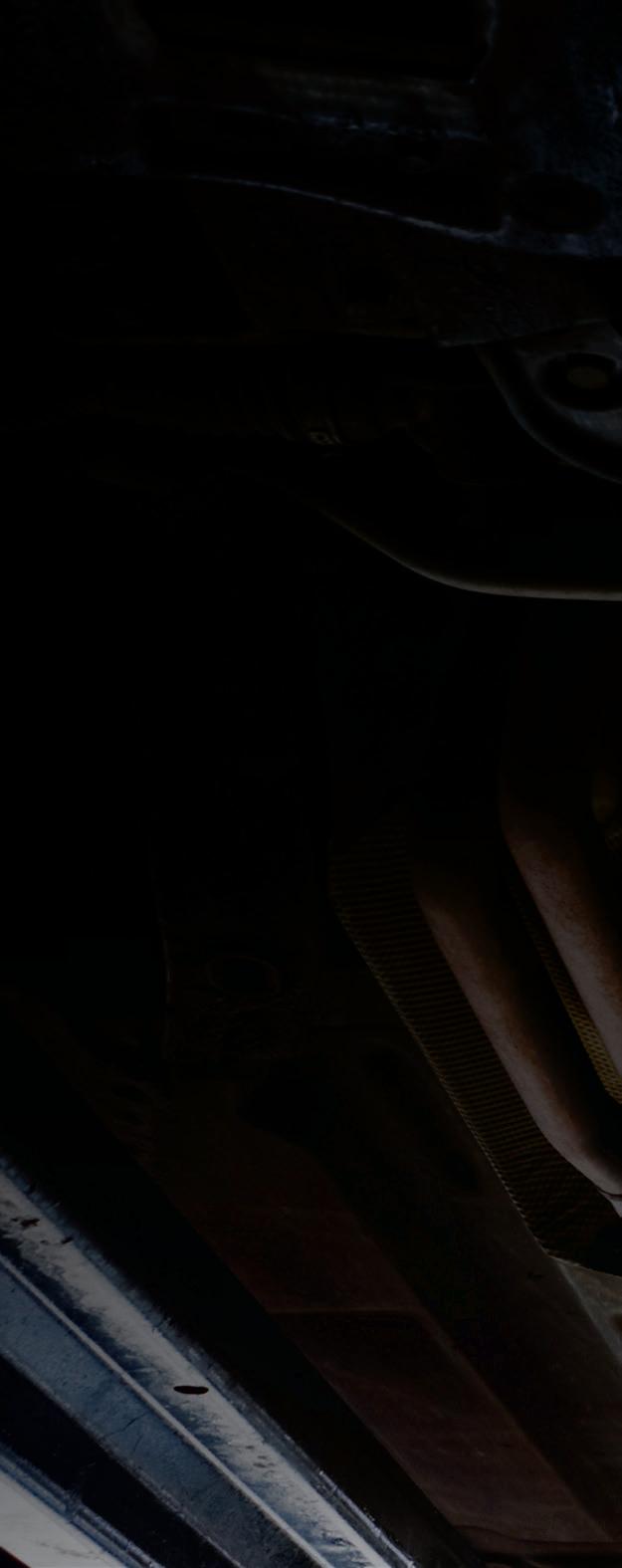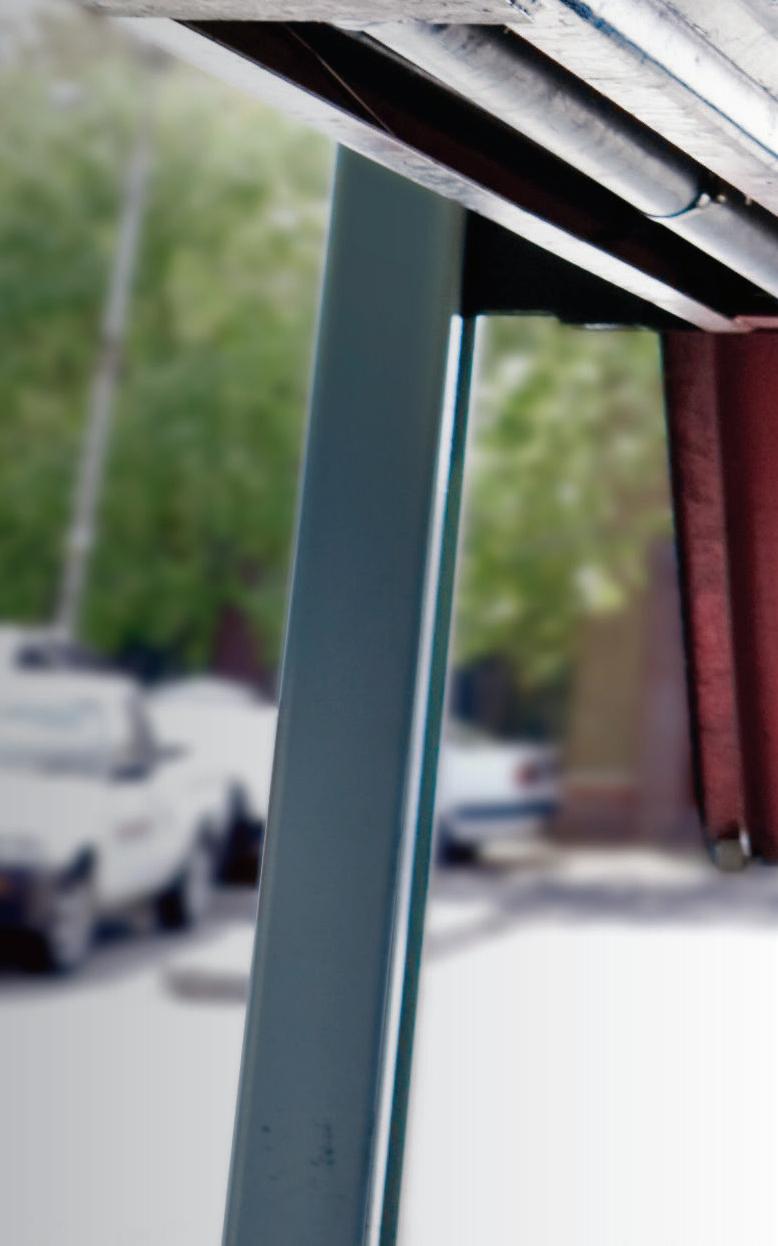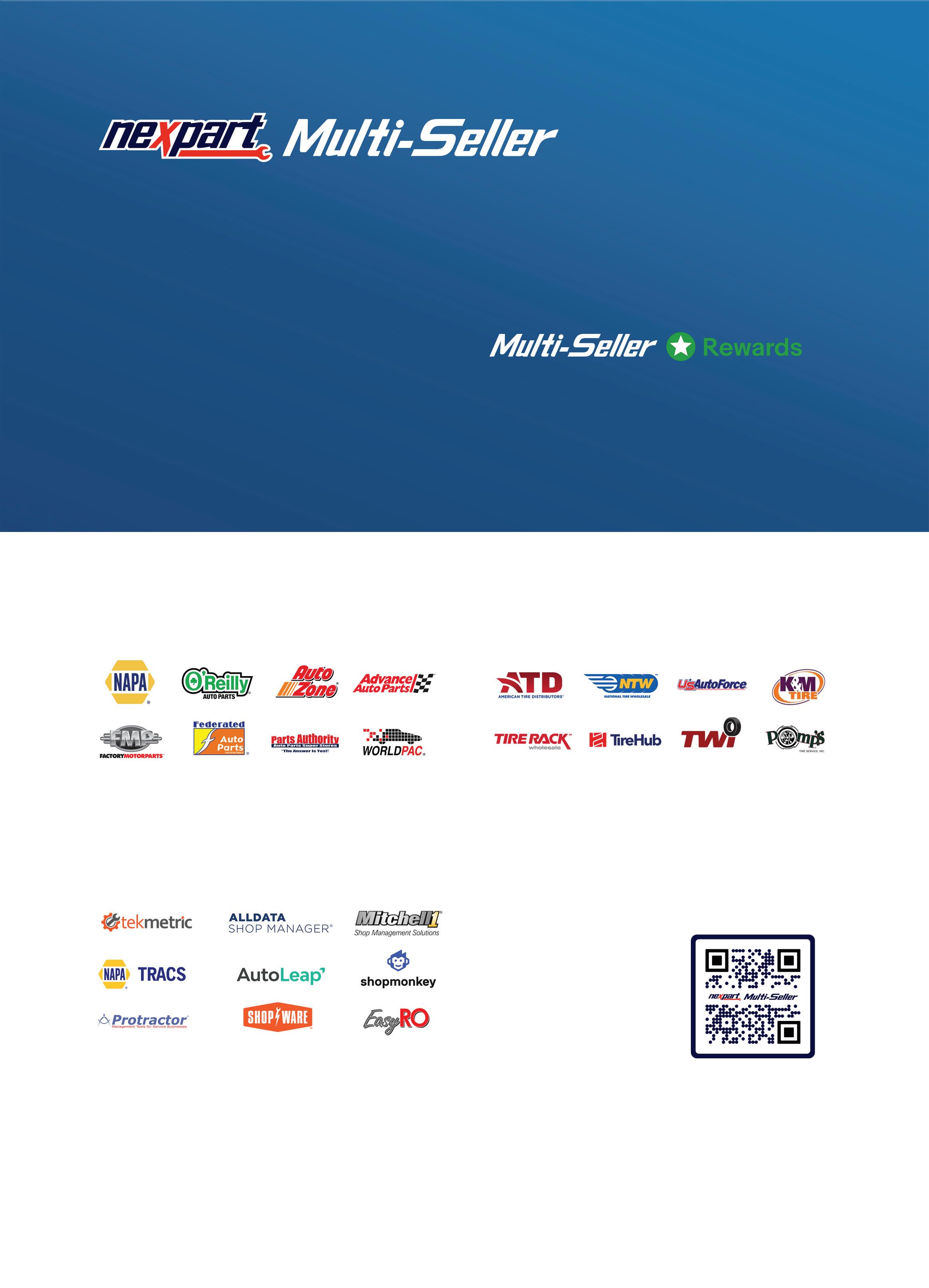HUSTLE & GROW

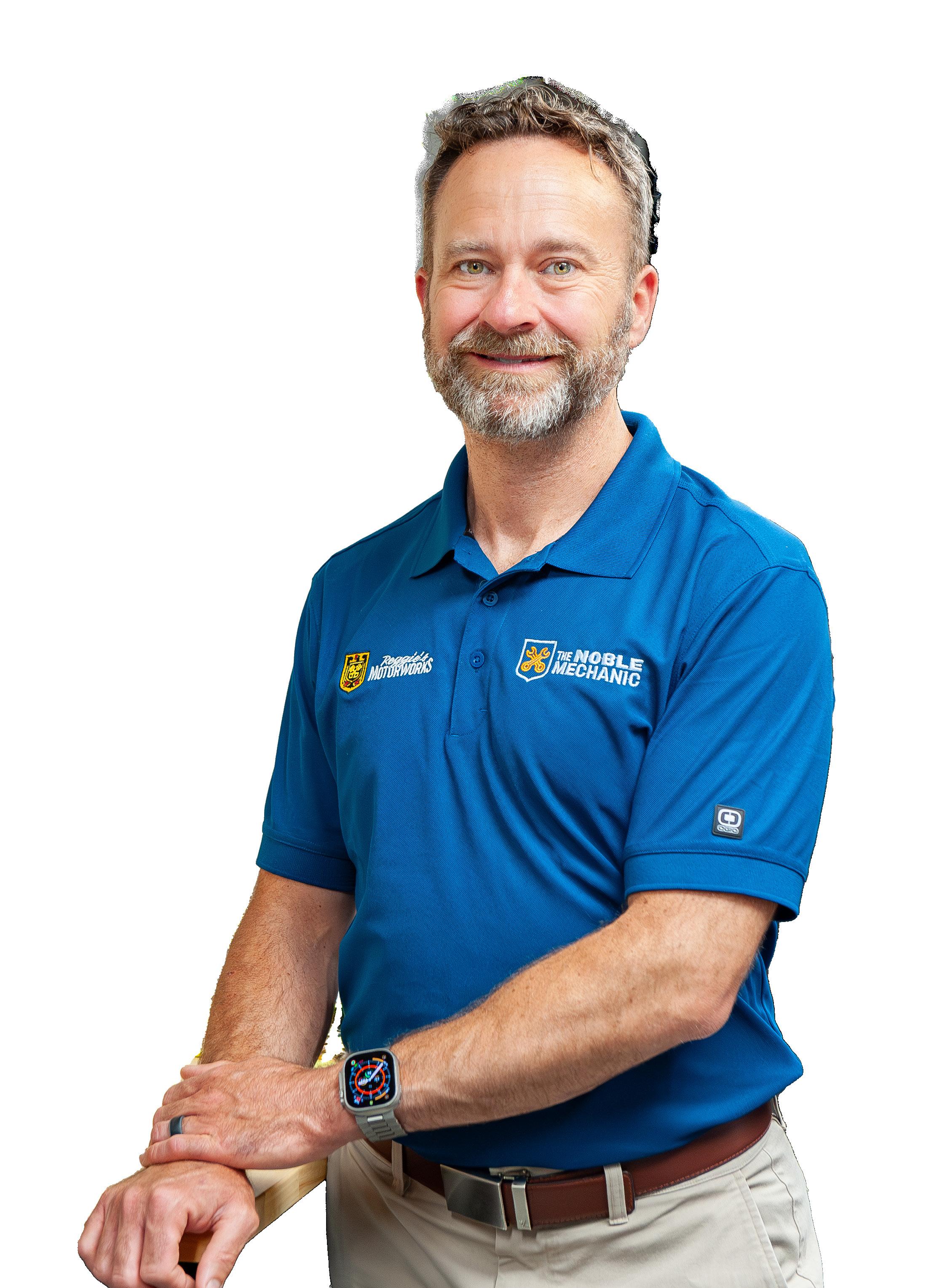



• Includes a 3-Year Warranty*
• Premium starting power and performance
• Built-in protection against temperature extremes
• High reserve capacity for emergency power
• Premium maintenance-free design for maximum convenience
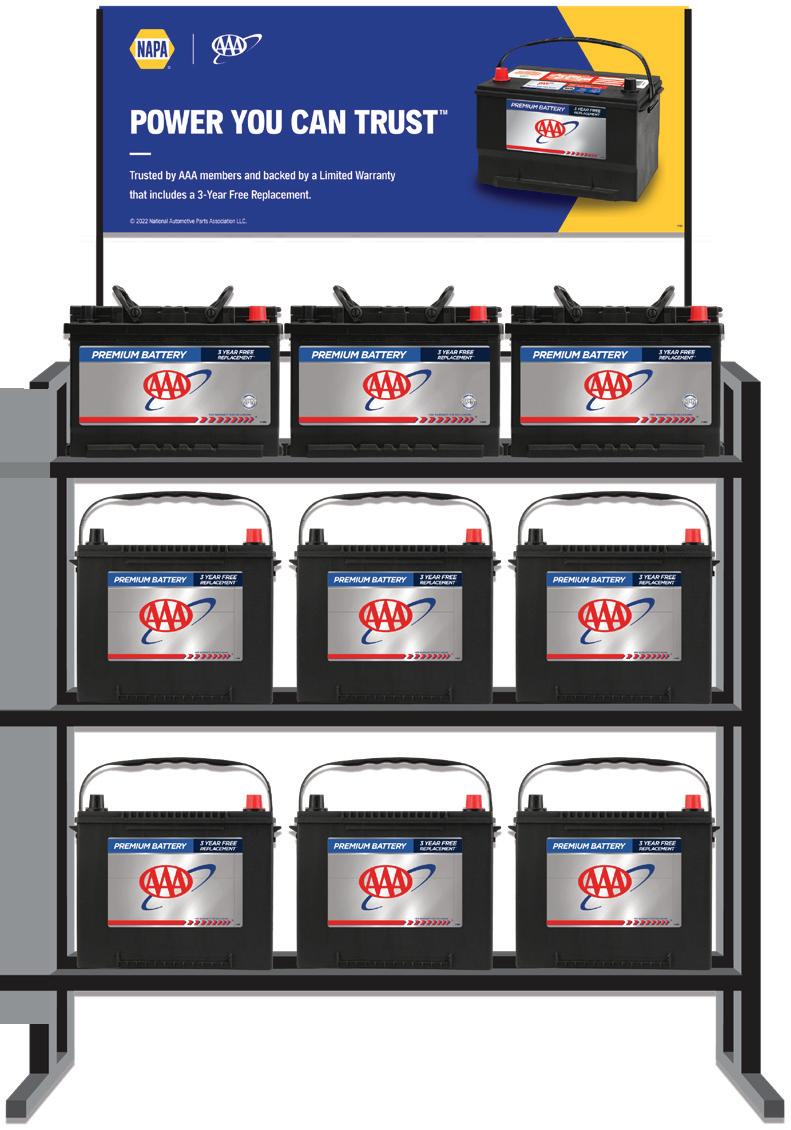

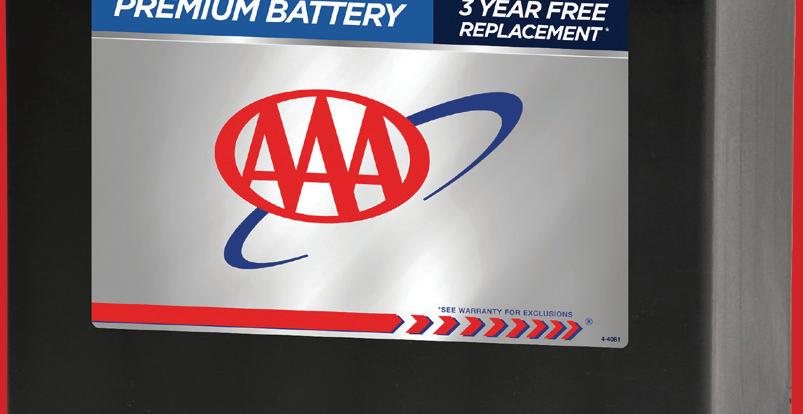

*3-Year Warranty covered by
Reach 65 million AAA members — tap into a massive, loyal customer base.
1 in 4 members need a battery each year — be ready when they do.
On-site battery availability — DEBI ensures immediate access to top-quality AAA-branded batteries.
Offer value-added promotions — NAPA funds consumer rebates during promotional windows, no cost to you.



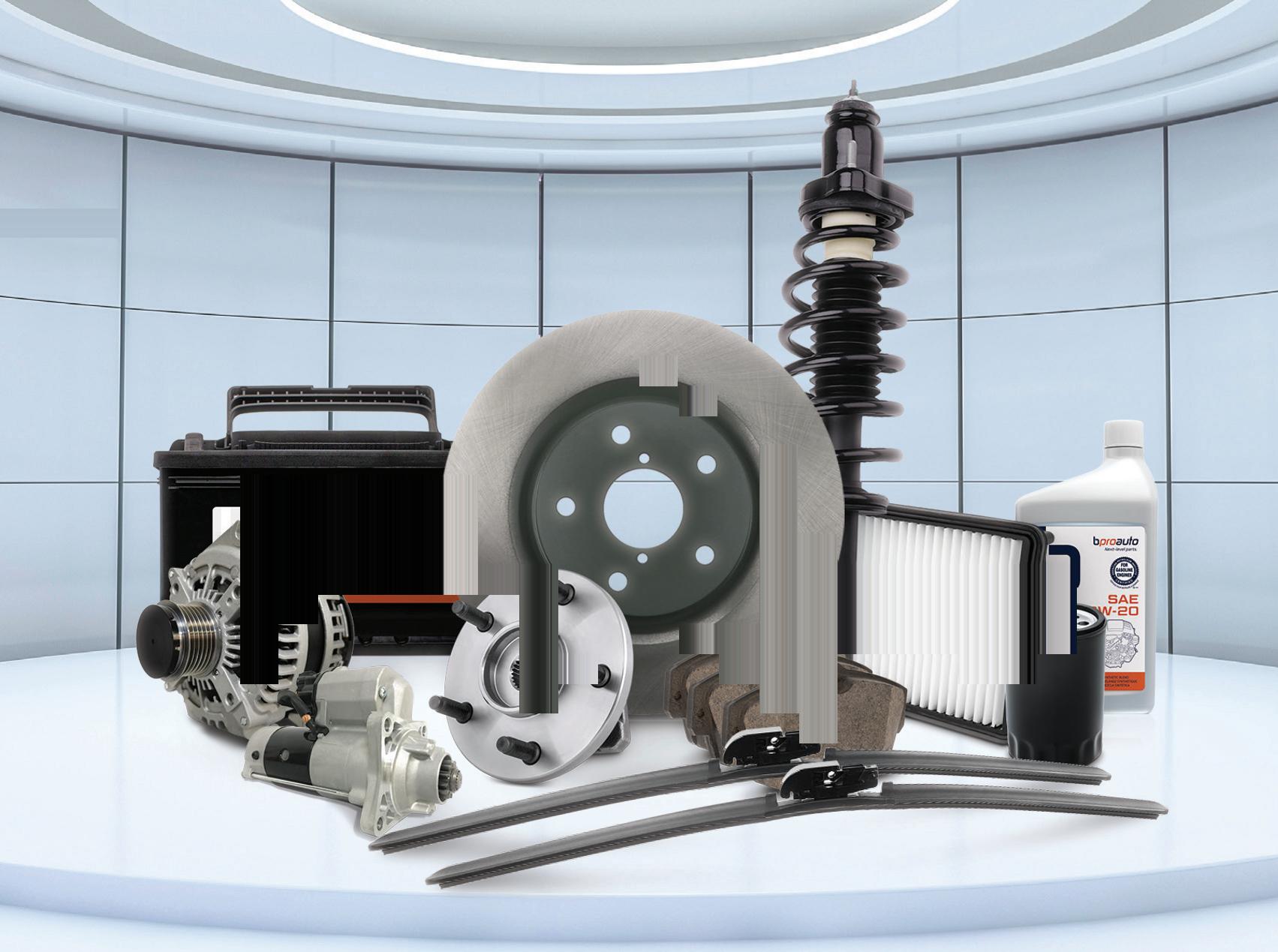
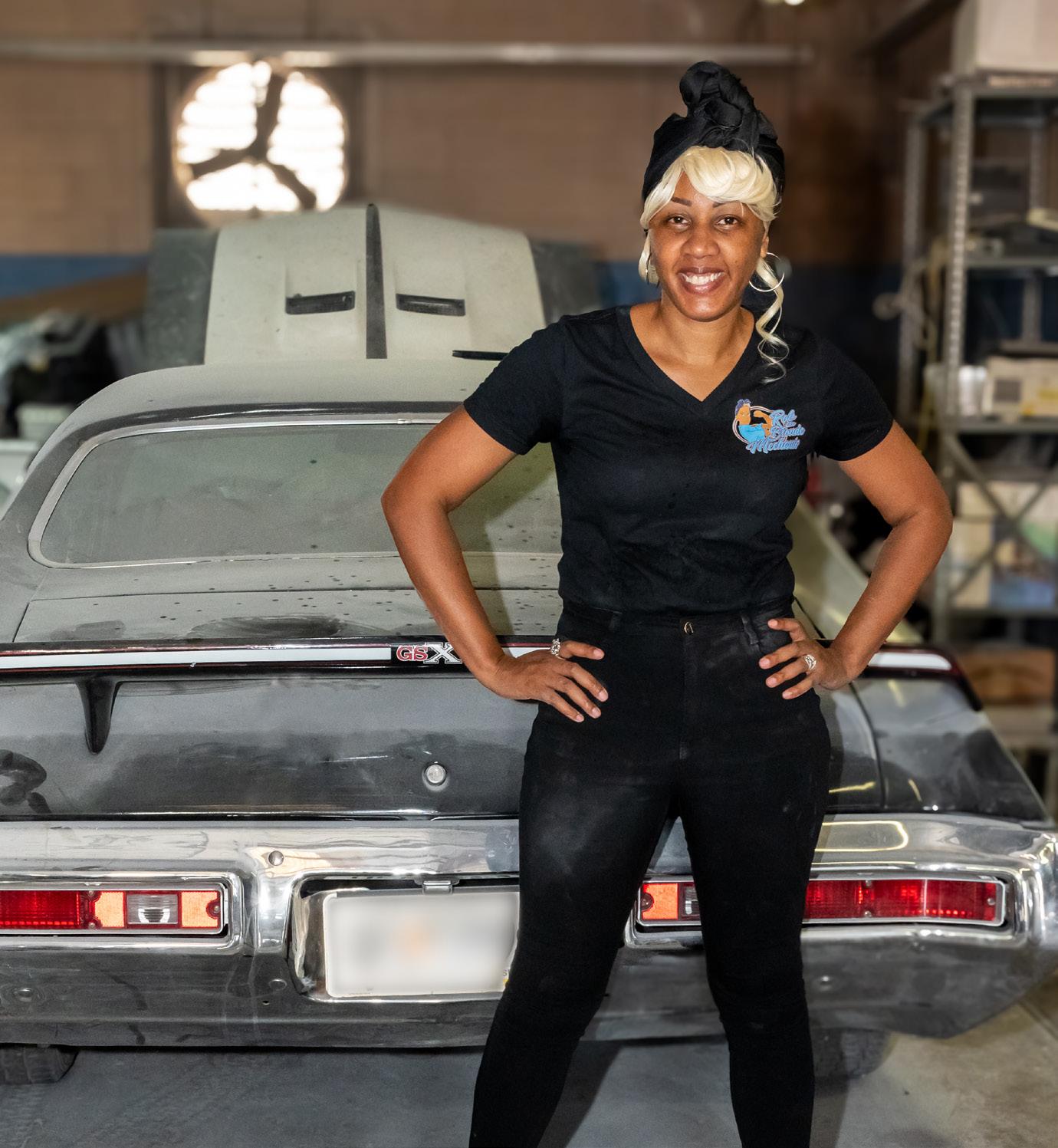
Reggie Stewart of Reggie’s Autoworks made money working as a DJ and selling cell phones and other electronics. He also pushed BMW parts on eBay. After borrowing $1,000 from his best friend to buy three old derelict cars, he rented half of an unheated pole barn and started turning his wrench in the middle of winter. That’s when he discovered his purpose.
BY KACEY FREDERICK
How single mother Robin Reneau found her calling as an auto repair shop owner and the nontraditional path she took to get there. And the three things she wants she wants you to know: Embrace who you are, don’t shrink yourself for anyone, and there’s room for everybody here.
BY ALISON JOHNSON
ON
COVER: Reggie Stewart, owner of Reggie’s Autoworks photographed by Kole Grove.
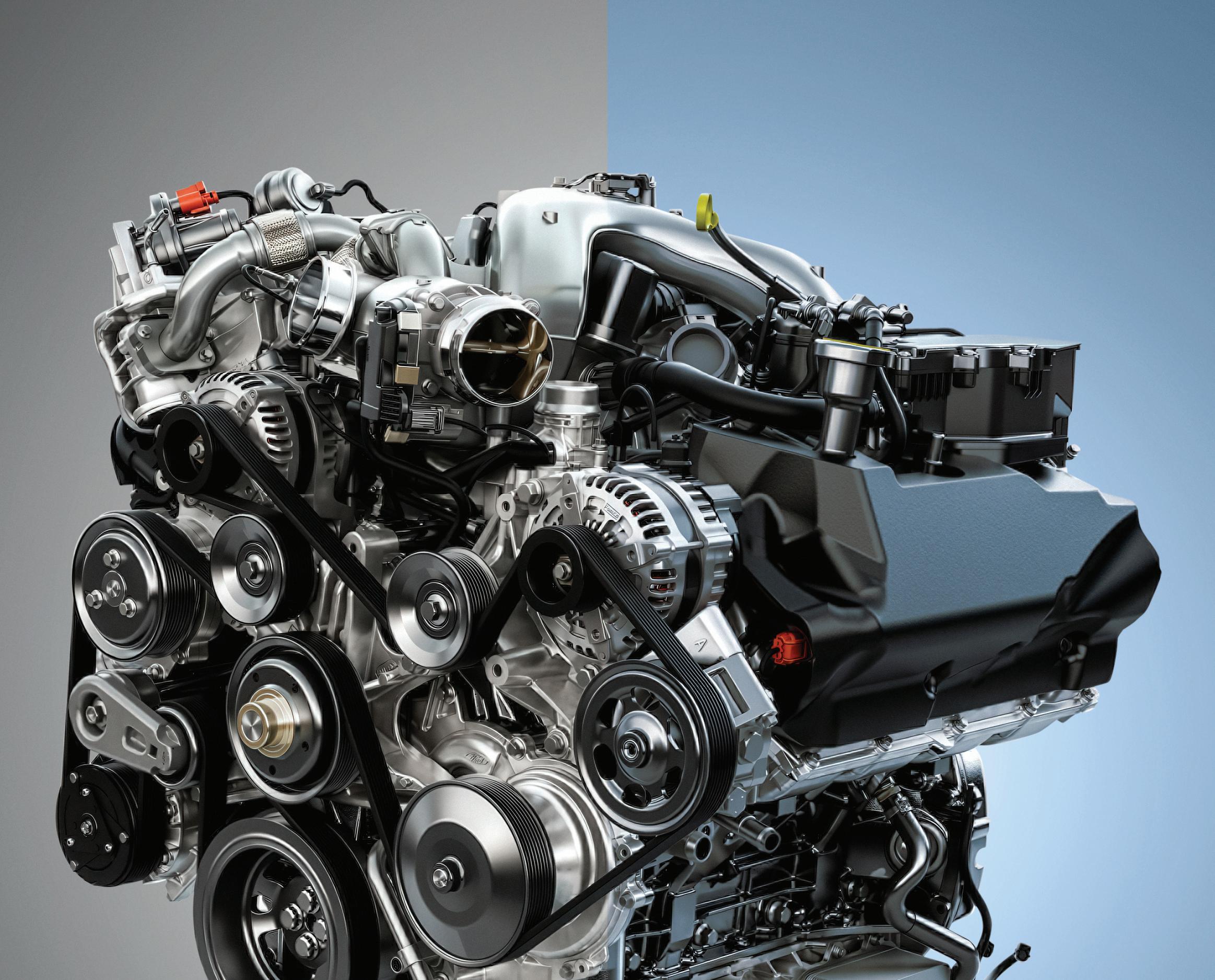
Precision-crafted Ford and Motorcraft® powertrain assemblies are built to all quality standards and OE specifications. They’re specifically engineered to fit and deliver consistently reliable performance and peace of mind: New and remanufactured transmissions and gas engines are covered for three years with unlimited miles, including labor, while diesel engines are supported by a two-year/unlimited-mile warranty (including labor). Plus, there are no exceptions for commercial vehicles. And with our no-risk core return policy, you don’t have to worry about extra charges if your engine or transmission core are damaged.*
Ford and Motorcraft make all the difference — for your customers and your business.
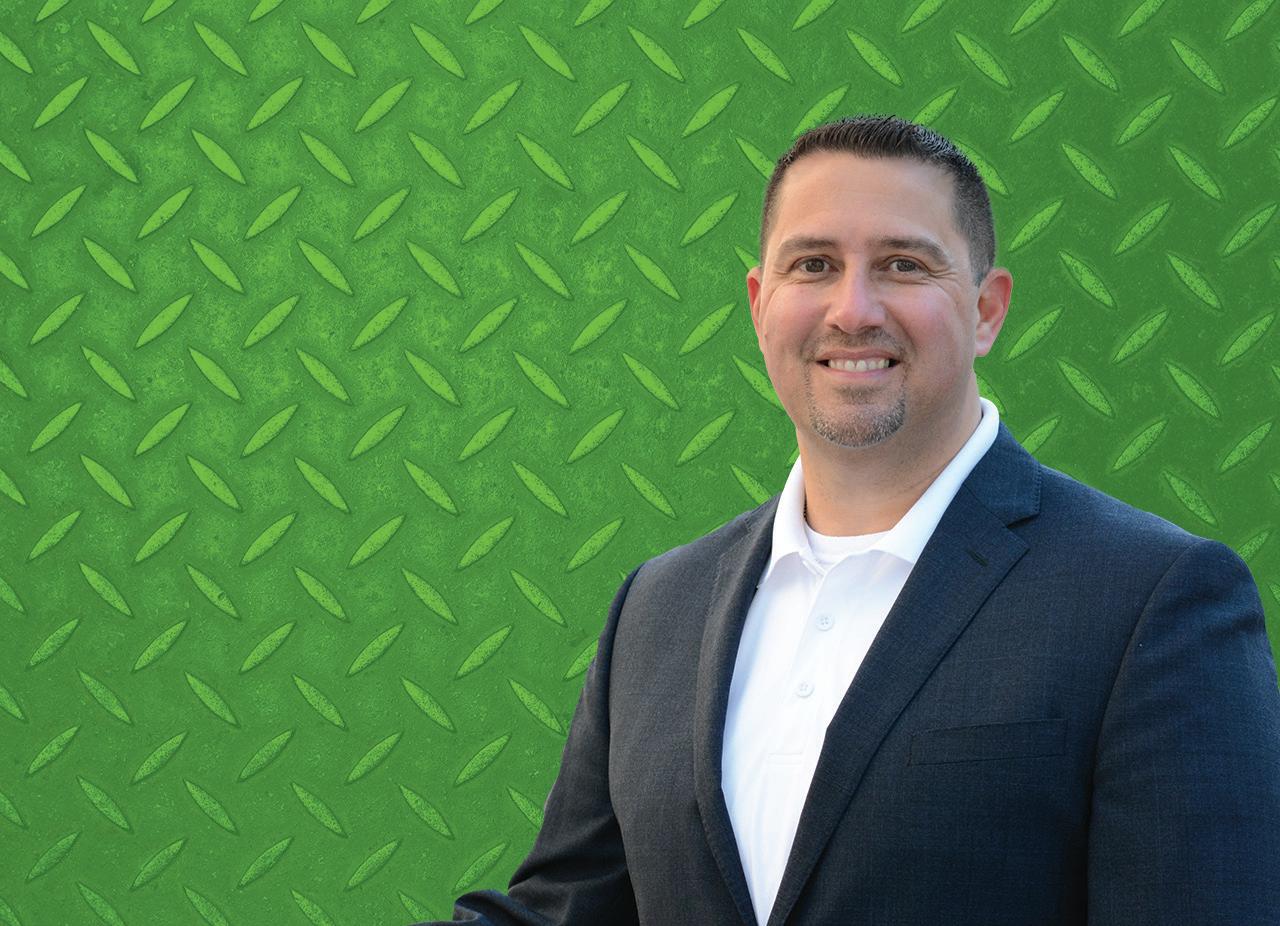

PODCAST: Time to Level Up: Real-World Best Practices That Actually Work
In this episode of Ratchet+Wrench Radio, Shawn Dupuie, senior director of sales and operations at Bosch, shares what it takes to build and sustain a successful modern shop. From fostering the right culture and tracking meaningful KPIs to retaining top technicians and structuring effective pay plans, he discusses the fundamentals that separate thriving shops from struggling ones. The conversation also dives into emerging technology, continuing education, and identifying warning signs before they become major problems.

HAYES: Private Equity: What to Know Before You Sell (Or Scale)
Private equity is transforming the landscape of the automotive aftermarket, with record-breaking investments flowing into auto repair. In this column, Todd Hayes, chief operating office of Adams Automotive and founder of Auto Shop Answers, pulls the curtain back on the process, explaining key terms, defining the “buy and build” strategy, and discussing how private equity works with options like rollover equity and strategic exits, shop owners have a rare chance to scale, sell smart, and secure long-term wealth.

SODHI: Risks You’re Taking with Your Auto Repair Shop’s Website (And How to Fix Them)
An auto repair shop’s website is one of its most valuable assets, yet many shop owners overlook theirs. A website acts as a 24/7 digital storefront—often the first impression a customer gets—and can outperform top salespeople in driving revenue. So why are many shop websites leased, templated, outdated, or not optimized for search and conversion? In his column, Taran Sodhi, founder of Conceptual Minds, teaches shop owners how to stand out in a competitive market by owning and investing in a custom, user-friendly, SEO-optimized site that reflects their unique brand. Done right, he says, and your website builds trust, drives leads, and helps scale your business with long-term marketing success.
RATCHET+WRENCH RADIO
Strategies and inspiration for auto care success.
Catch new episodes every Wednesday


EDITORIAL
EDITORIAL DIRECTOR
Chris Jones
EDITOR-IN-CHIEF
Chris Jones
ASSISTANT EDITOR
Kacey Frederick
CONTRIBUTING WRITERS
Tess Owings, Noah Brown, Alison Johnson, Emily Kline
EDITORIAL ADVISORY BOARD
Tara Topel, Topel’s Towing and Repair
Andrew Marcotte, American Pride Automotive
J.J. Mont, J.J.’s Auto Service
Rachel Spencer, Spencer’s Auto Repair
Tonnika Haynes, Brown’s Automotive
Lucas Underwood, L&N Performance Auto Repair
SALES
PUBLISHER
Andrew Johnson / ajohnson@endeavorb2b.com
ASSOCIATE SALES DIRECTOR
Mattie Gorman-Greuel / mgorman@endeavorb2b.com
DIRECTOR OF BUSINESS DEVELOPMENT
Cortni Jones / cjones@endeavorb2b.com
ACCOUNT EXECUTIVES
(NATIONAL ACCOUNTS)
Diane Braden / dbraden@endeavorb2b.com
Darrell Bruggink / dbruggink@endeavorb2b.com
Marianne Dyal / mdyal@endeavorb2b.com
Chad Hjellming / chjellming@endeavorb2b.com
Lisa Mend / lmend@endeavorb2b.com
Annette Planey / aplaney@endeavorb2b.com
Kyle Shaw / kshaw@endeavorb2b.com
Sean Thornton / sthornton@endeavorb2b.com
ADMINISTRATIVE ASSISTANT
Ryan McCanna
ART AND PRODUCTION
ART DIRECTOR
Emme Osmonson
PRODUCTION MANAGER
Mariah Straub
AD SERVICES MANAGER
Jen George
ENDEAVOR BUSINESS MEDIA, LLC
CEO
Chris Ferrell
COO
Patrick Rains
CRO
Paul Andrews
CDO
Jacquie Niemiec
CALO
Tracy Kane
CMO
Amanda Landsaw
EVP ENDEAVOR BUSINESS INTELLIGENCE
Paul Mattioli
VEHICLE SERVICE/REPAIR GROUP
AND FLEET AND TRAILER GROUP
Chris Messer
SUBSCRIPTIONS
Send address changes and subscription inquiries to:
Ratchet+Wrench PO Box 3257
Northbrook, IL 60065-3257
SUBSCRIPTION CUSTOMER SERVICE: 877-382-9187
ratchetwrench@omeda.com
LETTERS TO THE EDITOR
editor@ratchetandwrench.com
Opinions expressed in Ratchet+Wrench are not necessarily those of Endeavor Business Media, and Endeavor Business Media does not accept responsibility for advertising content.


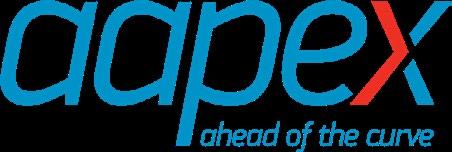
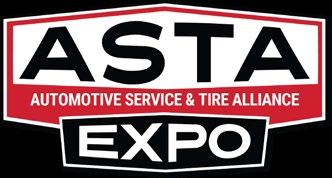


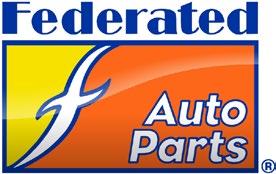
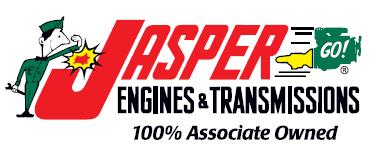

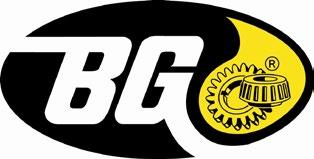

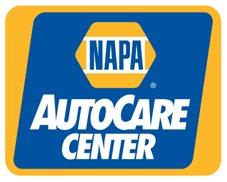




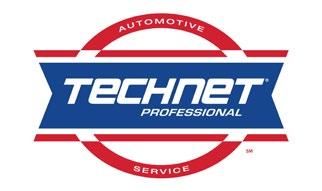




As a TechNet shop, I can provide the benefits of a large business while maintaining the personalized service of a small business. Partnering with my primary parts supplier through TechNet gives me peace of mind and ensures reliable support for my business. ”
NICOLE KERRIGAN
V&F Auto Service
TechNet Member Since 1998































































Level up your shop and get access to exclusive business and marketing solutions, including motorist programs like Nationwide Warranty, Roadside Assistance and Road Hazard Tire Protection.




Scan the QR code or visit technetprofessional.com/membership to learn more.
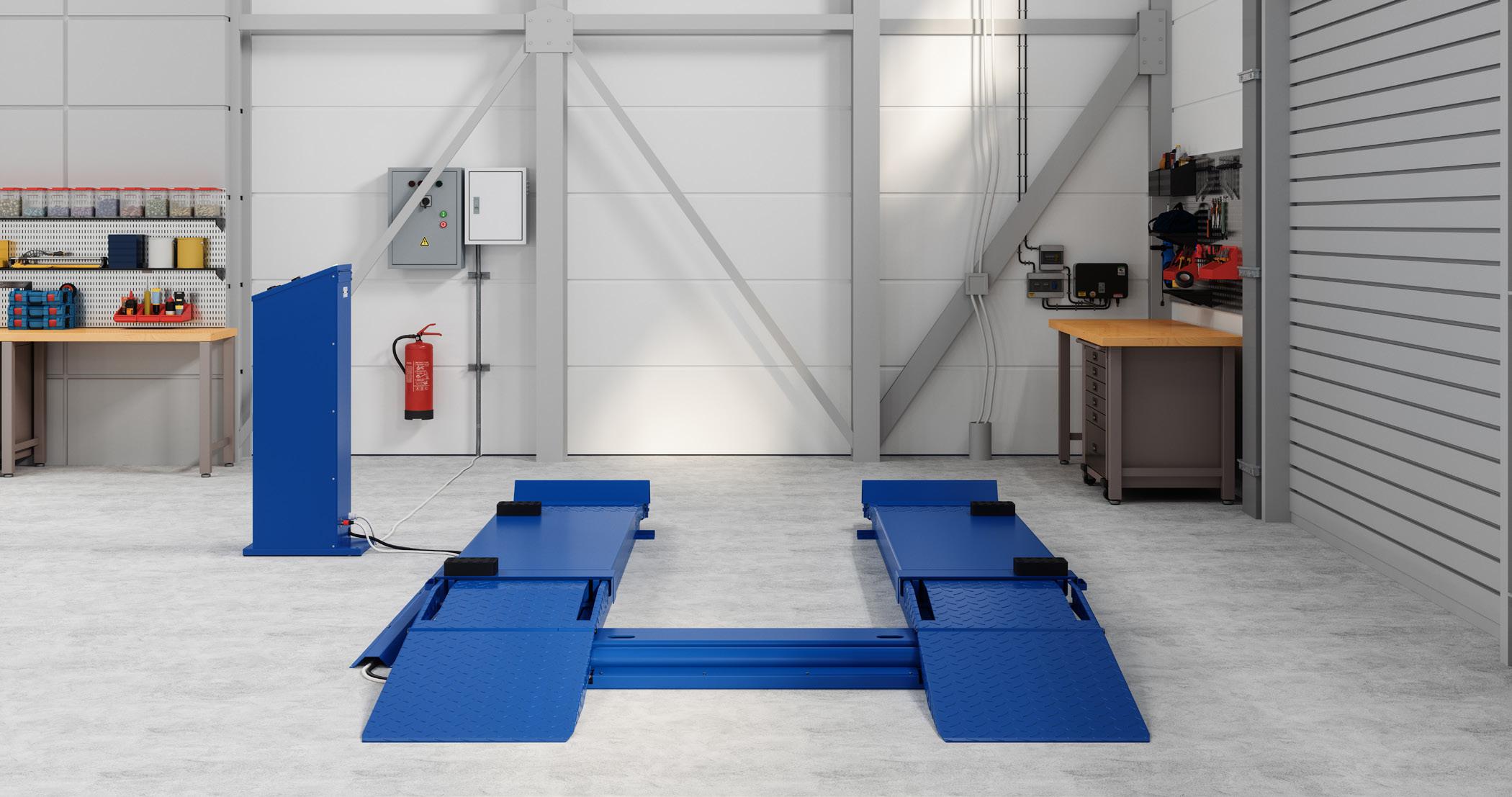
Matt Lachowitzer shares how he plans, budgets, and buys the right big-ticket tools to keep 10 shops running smoothly
BY EMILY KLINE
When it comes to purchasing large equipment, Matt Lachowitzer—owner and founder of Matt’s Automotive Service Center—knows it’s never just about the price tag. As the owner of a 10-location multi-shop operation—spanning from Minnesota to South Dakota—Lachowitzer has an extensive process for evaluating shop equipment needs and identifying reliable vendors.
Ratchet+Wrench sat down with Lachowitzer to find out the specifics of his
process and discover why it’s so important to do research when it comes to big equipment purchases.
Growing up on a farm in Central Minnesota, Lachowitzer always enjoyed tinkering around with the equipment and fixing it.
After graduating college, Lachowitzer decided to take on automotive repair. He jumped around working at dealerships for a
large part of his career. In 2009, he decided to venture out on his own and founded Matt’s Automotive Service Center.
“Over the last 16 years, it’s turned into an MSO,” Lachowitzer says. “It’s been quite an endeavor. The addition of shops was natural; we just kept expanding. We had a good grasp on the Fargo (North Dakota) market area, and we continued. I wanted to provide more opportunities for my team members to be able to grow. We’ve hit all the little cities in South Dakota and Minnesota that needed automotive repair to fit the needs of customers.”
Lachowitzer shops presently reside in Bloomington, Columbia Heights, North Branch, Pine City, and Willmar, Minnesota; and Fargo, Moorhead, South Fargo, and South Moorhead, South Dakota.
“I would say our success is based on how we’ve treated our customers and our team members,” Lachowitzer says. “I think that’s the two keys to success in any business, how you treat your customers and how you treat your employees.” Because of his 16 years of experience as a shop owner, Lachowitzer has a lot of insight into vendors and equipment purchase processes.
When budgeting for big equipment purchases, Lachowitzer finds it important to look at what his biggest needs are.
“We typically will identify that in our budgeting meetings,” Lachowitzer says. “We have our budgeting meetings towards the end of every year for the next year. So, if there’s any equipment that was earmarked the prior year, that gets risen to the top of the needs list.”
Because Lachowitzer runs a multi-shop operation, his team must be selective when choosing what equipment within the shop needs the most attention.
His team often pays special attention to serviceability when deciding if a piece of equipment needs to be replaced.
“One of the big factors we look at is if it’s beyond its serviceable life,” Lachowitzer says. “Have we had issues where we’ve had to repair it more than once in the last 12 months? That is the big thing that triggers us to start looking at whether we need to replace equipment.”
Along with identifying equipment needs in his annual budgeting meeting, Lachowitzer also ensures that the bigger pieces of equipment are inspected annually.
“It’s important to inspect your equipment to ensure it passes certification,” Lachowitzer says. “If it doesn’t meet certification and safety standards without being
repaired profusely, that means it needs to be replaced.”
Once the equipment that needs to be replaced has been identified, Lachowitzer then looks at which vendor to purchase from.
“A lot of the vendors I choose revolve around whether I’ve done business with the vendor before,” Lachowitzer says. “I also look at how they are taking care of things. Are they reliable? Are they responsive? Have we had any issues with warranties with this vendor in the past? Those are the big ones.”
Shop owners need to answer these questions. With big equipment purchases being such a large investment, it’s important to know what vendor relationships could look like throughout the lifespan of the equipment.
If working with a new vendor, then investigate the company. Many vendors have customer reviews available on their websites. If reviews can’t be found online, word of mouth—talking to other shop owners and technicians—is always a good way to find out vendor capabilities.
In addition to researching vendor reviews, it’s also important to look into the company’s service abilities.
“If a piece of equipment breaks down, that costs the shop money,” Lachowitzer
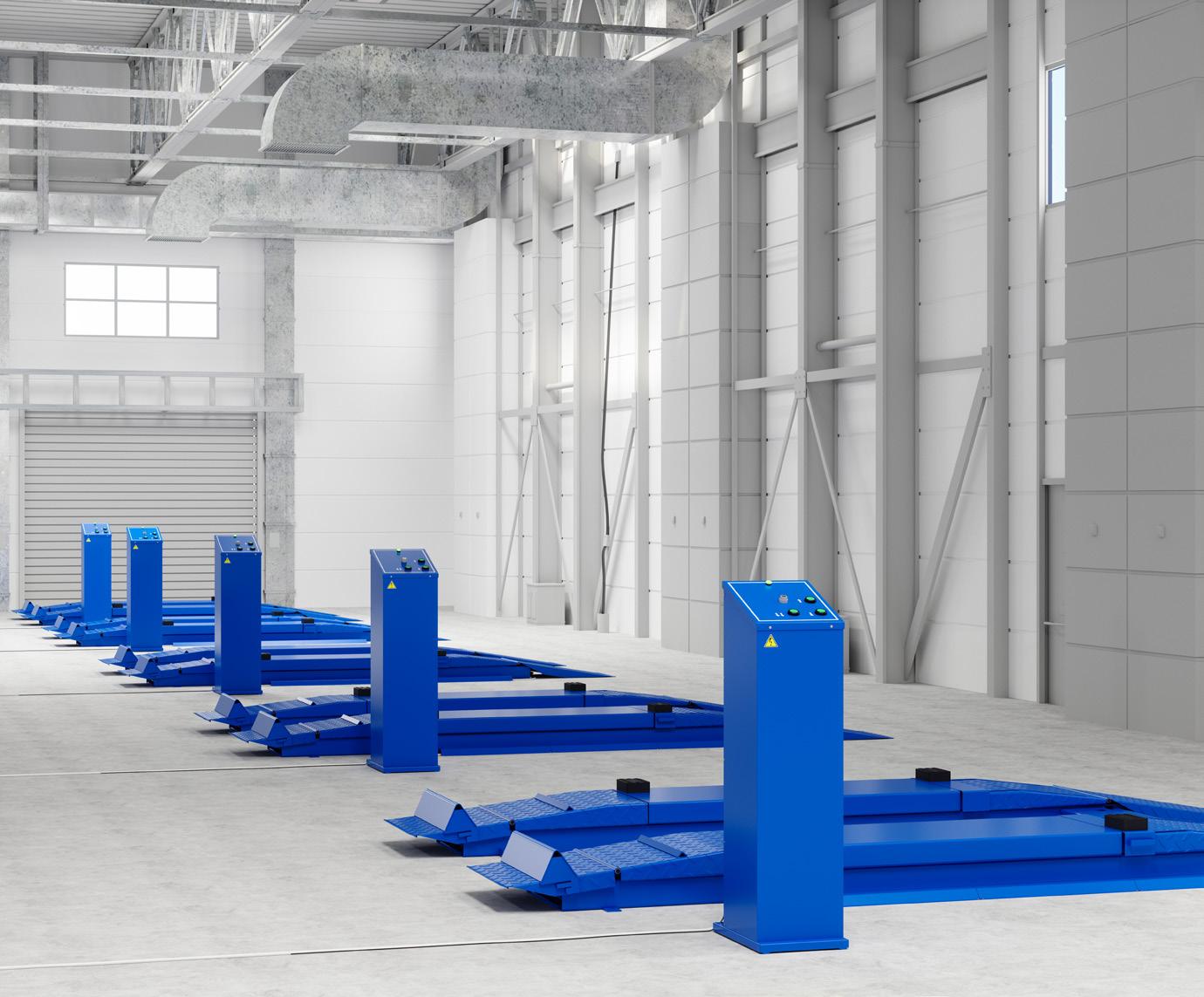
says. “We want to make sure that whoever we buy from is responsive and takes care of us. To me, that’s almost more important than the prices.”
Lastly, shop owners should make sure they thoroughly understand the ins and outs of the vendors’ warranty on the piece of equipment.
“You should understand how that warranty is handled,” Lachowitzer says. “So, if you’re looking at a guaranteed warranty but there’s no service centers nearby—and you have to bring it in or haul it somewhere to get service—you should consider that.”
When deciding whether to purchase or lease big equipment, Lachowitzer recommends considering the tax advantages of both.
“Leasing allows you to keep your cash, and purchasing doesn’t,” Lachowitzer says. “There are tax incentives for both as well. There are (Section) 179 deductions and things like that. When you purchase something, you can get a 179 bonus, appreciate it, or you can expense it over five or seven years, compared to a lease.”
With leases, a shop owner can write off the entire lease payment. They don’t have an asset to dispose of, but they get to write off the lease.
The other component Lachowitzer considers is the cash side of things. If a shop owner buys something, they’re financing it. It’s important to look at what the terms look like if the shop is paying cash for it. It’s also important to consider whether the shop has the reserves to build to do it.
“On the leasing side, it’s important to consider if the payment works with what you’re doing,” Lachowitzer says. “The biggest thing for every piece of equipment you must ask yourself if it’s a need. Is it going to affect our cash flow if we buy or lease this? What’s the objective of what we’re trying to accomplish by buying this piece of equipment? So, if it’s a new piece of equipment, what’s going to be the ROI on adding this piece of equipment to our facility?”
When it comes down to it, shop owners need to do their research. Purchasing large equipment is a big purchase for any shop and—hopefully—a long-term commitment.
Without doing the appropriate research on the shop’s needs and the equipment vendor, shops could get stuck with something for years that doesn’t work for them.
Millions of parts in-stock, ready to ship from four locations across the nation.
Parts available from over 1,500 top-brand name manufacturers. If you can’t find it, we’ll get it!
Unbeatable customer service.










millions of parts from 1,500+


the

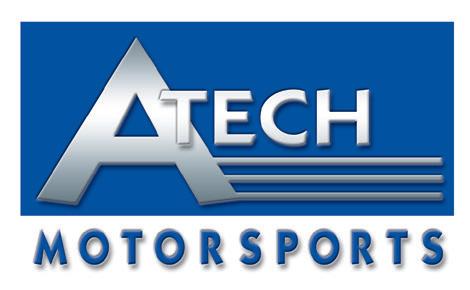



Cloud-based auto shop management platform Shopmonkey will now offer payment installment plans via Affirm as part of its payment processing solution, according to a press release.
Eligible U.S. and Canadian auto shops will now be able to offer Affirm’s pay-over-time plans when invoicing their customers.
Approved customers will have the option to split the total cost of their auto repair bill into budget-friendly biweekly or monthly payment plans, potentially for as low as 0% APR.
“We believe the automotive care experience starts the minute you drive the car off the lot until you turn the keys over to the next owner. Offering flexible payment options like Affirm is a natural extension of that belief—helping empower our customers (and) deliver a superior automotive care experience,” said Travis Bickham, chief commercial officer at Shopmonkey.
“We are excited to partner with Affirm

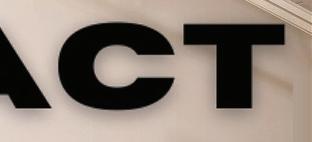



given their commitment to bringing innovative customer-centric solutions to market.”
Sun Auto Tire & Service has acquired five Fausak Tires and Service locations, marking its entrance into the state of Alabama, as shared in a recent press release.
First opened in 1962, Fausak Tires has been serving the Mobile community for over 60 years. The five stores now join Sun Auto’s network of over 500 locations.
While Sun Auto has established a nearby presence with Delta World Tires in Mississippi and Louisiana, this will be the brand’s first acquisition in the state of Alabama.
“Fausak Tires and Service marks an important step in our growth in the Gulf Coast region,” said Regional Vice President Michael Loa. “We partner with companies like Fausak for a reason—with a long track record of success and history of community
stewardship, Fausak is a great Gulf Coast addition for Sun and will thrive with additional regional and national support.”
Ford has issued a recall for nearly half a million vehicles due to a door trim prone to detaching while driving, reports Associated Press.
The recall covers 492,145 Ford Explorers from model years 2016-2017. Ford attributed the problem to a lack of proper adhesion to the trim.
While the automaker had been aware of the issue as early as 2019, it did not issue a recall, determining there was no threat to safety. However, in March, the National Highway Traffic Safety Administration shared with Ford dozens of vehicle owner reports related to the problem. This prompted an investigation by Ford.
A remedy for the faulty part has yet to be announced, but affected vehicle owners received letters after June 9.





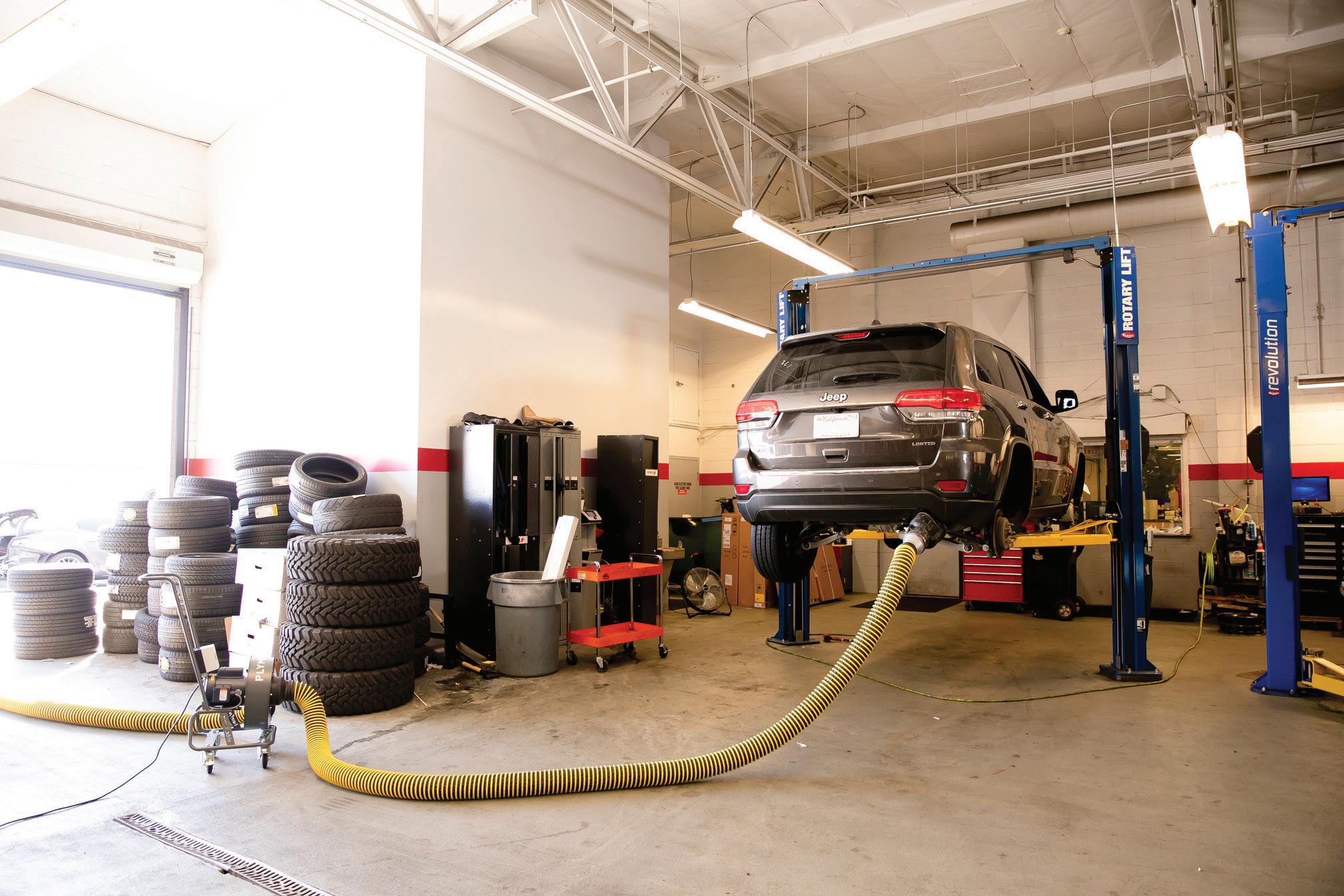

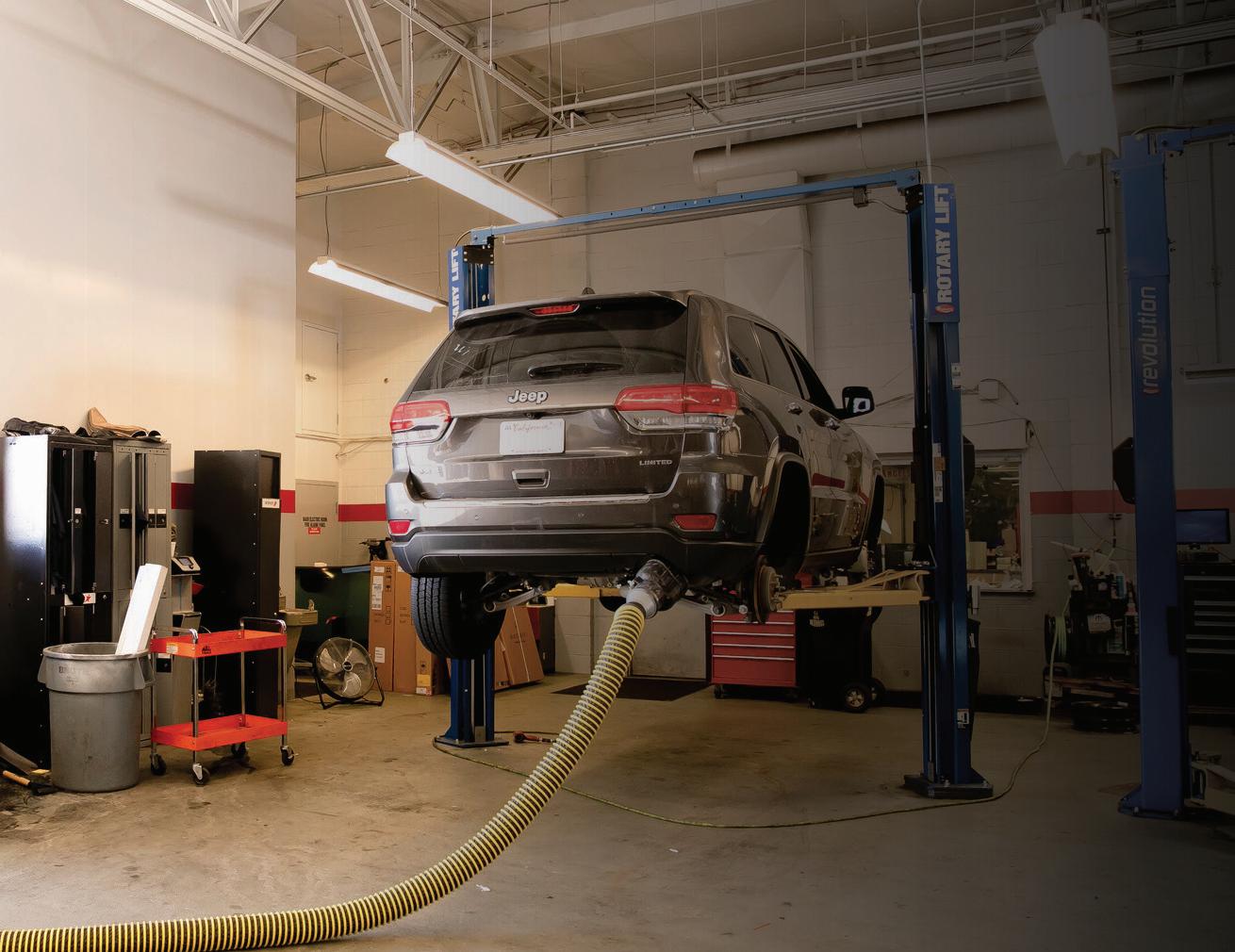




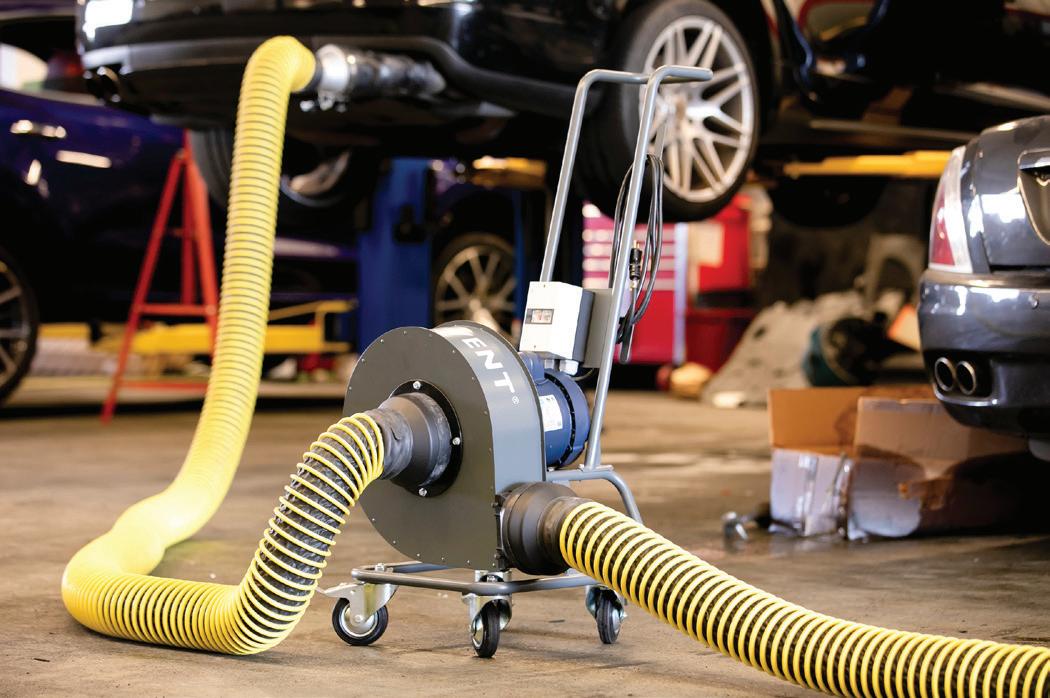
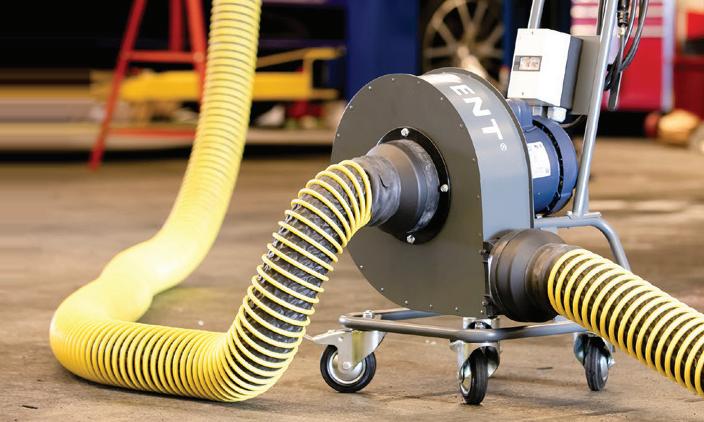




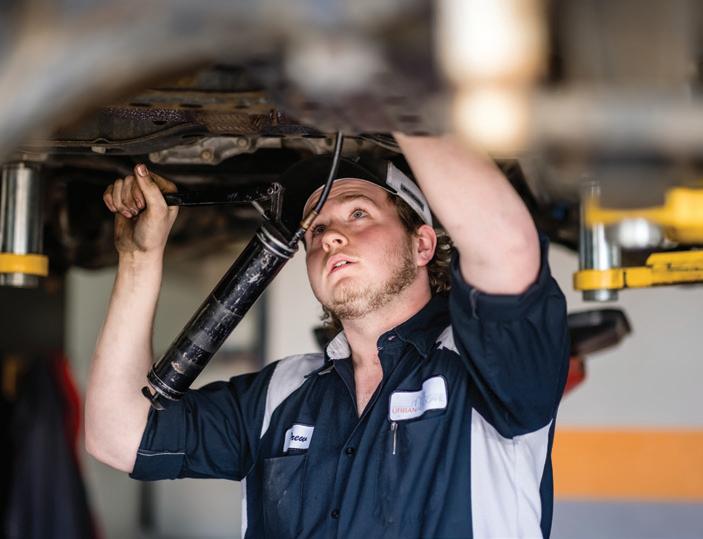










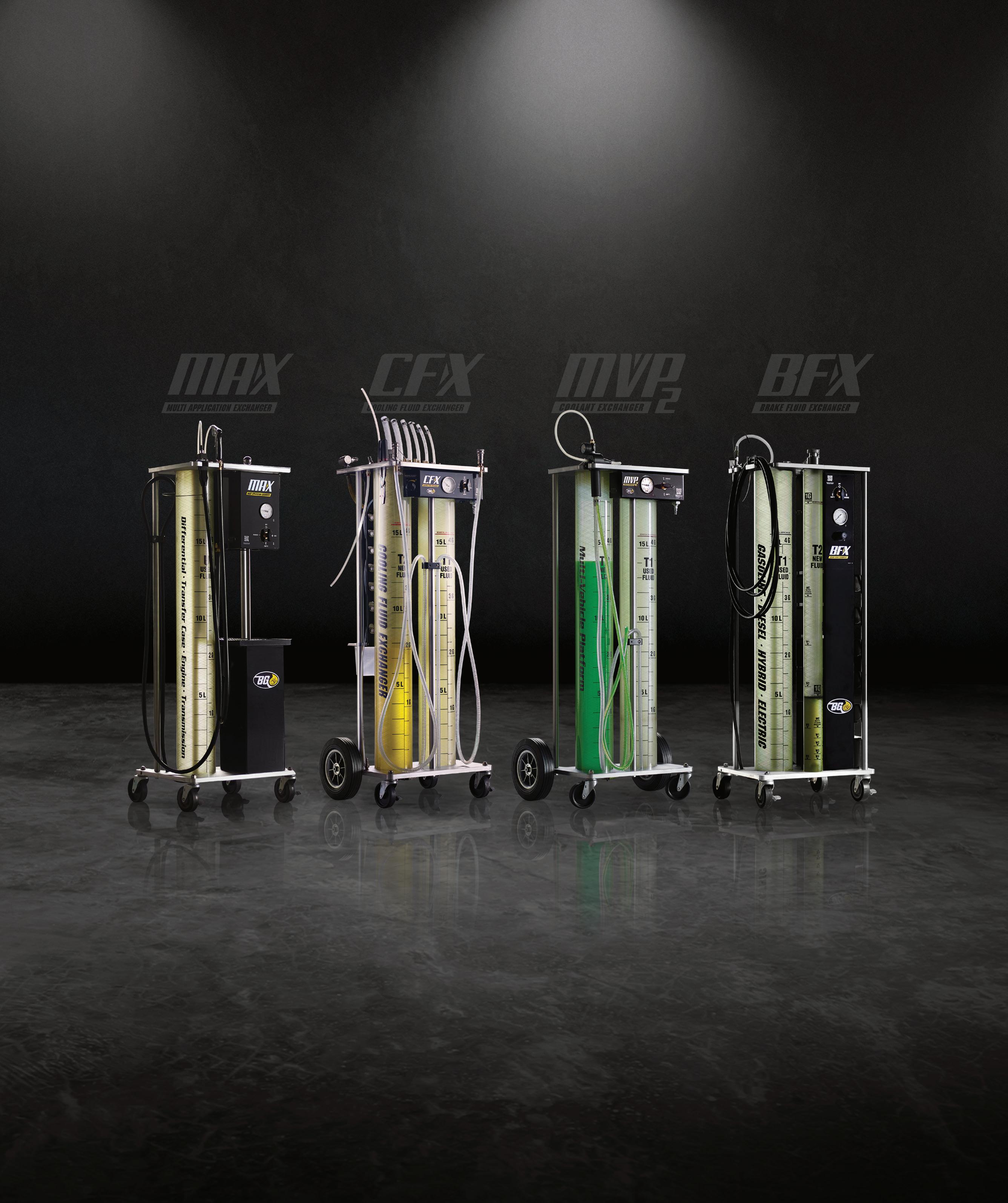



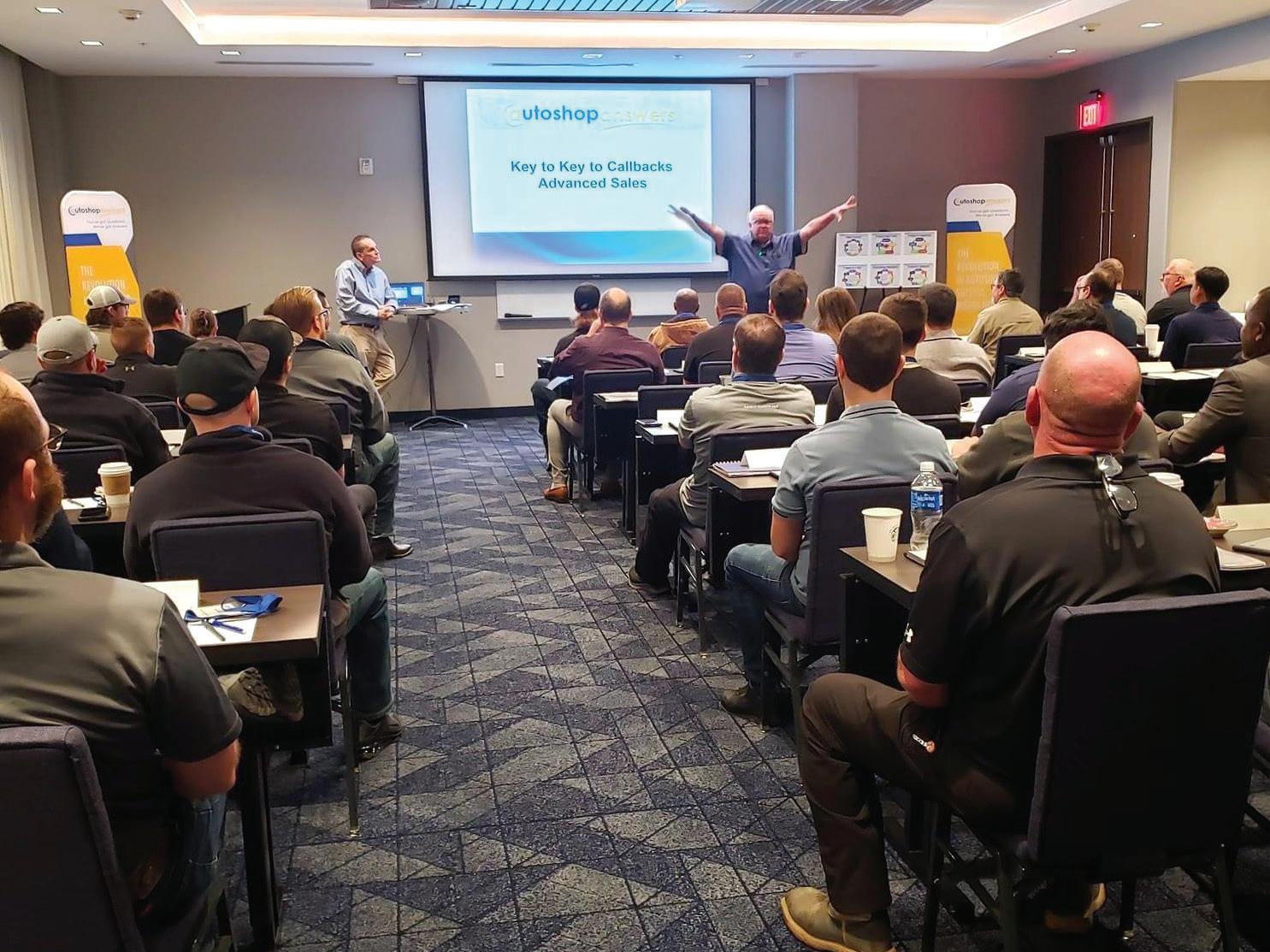

We have not just enhanced, but mastered, the concept of car repair. With monthly revenue figures over $1 million, our system guarantees exceptional customer service and unprecedented sales numbers.

A full day of learning the new AI tools being used in our shops. Spend the day in a deep dive with the industry’s best teachers of AI. This class will elevate your shop to new heights!
“If you’re not counting your money, someone else is.” Financial / P&L Statements Budgeting, Projections & Forecasting Inventory Management Fraud & Embezzlement Plus so much more!




BY CHRIS JONES
Over the past few years, the automotive aftermarket has experienced a significant boom in digital-driven services powered by artificial intelligence. AI-powered scheduling systems lead the way with over half of the 2025 Ratchet+Wrench Industry Survey Report respondents (52%) noting that their shops incorporate these tools into their processes.
Online booking and digital communication platforms have nearly doubled their presence in U.S. auto repair shops, growing from 33% to over 60% adoption in recent years, according to Shopmonkey. This shift aligns with a growing consumer preference—60% of Americans—who prefer booking appointments online over traditional phone calls, which only 33% of customers say they prefer.
Which tools are auto repair shops using most?
Jason Smith, owner of M&M Car Care Center with locations in Merrillville, Schererville, Dyer, and Hammond, Indiana, says online booking is reducing the number of incoming calls his service advisors have to attend to. Smith sees between 5% to 6% percent of total bookings made online each month, with most customers who book online coming in for simple services such as scheduled maintenance and oil changes. (“How Online Booking Can Help Shops,” January 2024)

Greg Bunch of Transformers Institute shares how to build a plan for continuous improvement—even when your schedule is packed
BY KACEY FREDERICK, GREG BUNCH
In automotive repair, training and education are an absolute necessity. Even the most experienced technician requires continual training as the industry changes. That doesn’t change for those who operate auto repair shops—on the contrary, there’s a vast array of different skill sets that will need to be exercised if you’re to thrive.
As the founder and CEO of both Aspen Auto Clinic, a six-shop operation in Colorado, and auto repair consulting company Transformers Institute, Greg Bunch has worked with countless shop owners on innovating new ways to run their businesses in the midst of hectic schedules.
Here, he breaks down how you can narrow your focus and set up a plan for continuous improvement.
To get a good idea of where you should be focusing your efforts, it’s best to analyze your finances, not just surface-level skimming, but understanding what each metric means and acting accordingly.
“That’s mission-critical to any business,”
says Bunch. “I work with a lot of shop owners that are multi-store, multi-million, who are still kind of running their business through their checkbook and not fully understanding the importance of financial statements; how to read them, how to manage them.”
While Bunch has heard from many who tout a 60% gross profit as the ultimate goal, bigger companies have made most of their money from focusing on high-ticket jobs, such as shocks, struts, and brakes. The key is understanding what specifically will work for your business and starting from there.
“A shop owner needs to be cognizant of the fact that every action has a reaction. Every KPI has emotions behind it, and has long-term and short-term consequences—both good and bad,” explains Bunch. “And unless you get a good understanding of what your strategy is, you could think you’re fixing your company in the short term, but having a negative long-term effect.”
For that reason, understanding finances can provide the clearest look into your business, and help lay the groundwork for what you may want to spend your time on learning more about and experimenting with. Take the time to learn how to read financial statements, how to manage those statements, the difference between gross profit percentage and actual dollars earned, and not to focus on just one financial metric.
As a shop owner, training and learning look a lot different from that of a technician or service advisor. Rather than specializing in a certain area, you have to learn to be what Bunch calls a generalist: not an expert in everything, but someone who has a baseline understanding in each area of the business.
This includes taking the time to understand marketing, sales, technology, and human resources; again, not with the goal of being a master in each one, but educating yourself enough to engage with those crucial parts of your business.
“I think it’s a transition that’s difficult for a lot of shop owners, especially those who started as technicians. They’re comfortable in the shop, and they feel satisfied when they suit up, go in the back, and fix a car that’s been there for three days that nobody else can fix,” tells Bunch. “There’s a time and a place for that, but at the end of the day, you’re fix-
ing a small problem, and may be allowing a bigger problem to manifest because you’re not paying attention to the rest of the components of the business.”
So, you have an idea of what areas should be on your radar, but how do you go about doing the work to learn more? It’s easier said than done. It will take pure discipline to build a strict schedule that you can adhere to. Plan your day, and schedule a couple of hours sometime to sit down and do nothing but learn.
The way you learn can take shape in a lot of different ways. Whether it’s through reading a book or attending a webinar, it will be time well spent. Listening to podcasts can also be helpful, especially as they can be consumed while doing other tasks or during long commutes. It’s all about getting creative with how you can work in time for you to learn about whatever skill you want to improve.
“A lot of shop owners go into their shop every day, and whether it’s a fiveminute or 50-minute commute, there’s time to get some nuggets on their way there and back,” explains Bunch. “I speak a lot and travel to different shops, and I have leveraged that time on the airplane. I put in a good audiobook, have my laptop open so I can make notes, and ask, ‘How does this apply to my businesses?’”
No one will be able to study for the entirety of each time block every day without fail—sometimes things outside your control will crop up and demand immediate attention. But if you’re able to accomplish even half of the time you set aside, you’re making a difference.
It isn’t enough to learn; it’s what you do with the knowledge you gain that matters. Have an action plan for what needs to be improved in your business and how you will get there. Having others in the industry to connect with, especially a coach, can help with holding you accountable and keeping you motivated to pursue consistent improvement.
In situations such as attending a conference, where you’re absorbing a lot of info at once, it can be helpful to take a day or two afterward to digest what you’ve learned and how to act on it.
You won’t see instant results. As with most things in life, it’s all about staying
steadily on a path of improvement that never ends. It isn’t until years down the line that you’ll look back and see how much you’ve learned and built up.
“Don’t try and eat the elephant all at once. If someone can afford it, I think getting some additional help will get you there faster. But at minimum, I think Stephen Covey said it in ‘The 7 Habits of Highly Effective People’: Take time to sharpen the saw,” says Bunch. “Start with a book like ‘The E-Myth’ (by Michael Gerber), digest it, and apply it to your business. Get the next book, digest it, apply it to your business.”

Greg Bunch Founder and CEO, Aspen
Auto Clinic
Greg Bunch is the founder/CEO of Aspen Auto Clinic, an awardwinning six-shop operation in Colorado. He’s also the founder and CEO of Transformers Institute, a training, coaching, and consulting company for the auto repair industry with a goal to “Transform the Automotive Industry.” Throughout his career, Greg has worked as a technician, service advisor, manager, business owner, speaker, and consultant.
greg@transformersinstitute.com
Using the right tech tools streamlines operations and improves service quality
BY KATHLEEN CALLAHAN
Last month, we talked about client-facing technology to improve your customer experience. Most shops realize that using internal technology plays a critical role in improving shop efficiency, which also contributes to an excellent customer experience with your shop. Now we’ll explore how those technologies can enhance service delivery, streamline operations, and ultimately improve customer satisfaction.
Clients benefit from service reminders, texting options, and appointment scheduling, but your staff also benefits from it. By sending satisfaction surveys or online review requests, you show clients that their feedback matters, thereby strengthening the bond between the shop and the client. Sharing customer feedback regularly with your team helps them celebrate excellence when achieved or improve when they miss the mark. You could incentivize your staff based on their reviews.
DVI systems aren’t just beneficial for customers; they also improve internal shop operations. Here’s how:
• Improved communication and transparency. With DVI, technicians can document issues more thoroughly, ensuring that service advisors and clients have the necessary information to make informed decisions.
• Streamlined workflow. DVI lets technicians clearly identify and communicate repair needs, which reduces misunderstandings and enhances overall workflow efficiency.
Internal inventory management technology allows shops to keep track of parts and materials, reducing delays and ensuring that
work is completed on time and billed accurately. No one wants an angry customer who says they were overcharged or repair was delayed because the part wasn’t ordered to fulfill delivery expectations. This helps avoid unnecessary confrontations. Here’s how:
• Efficient stocking. Proper inventory tracking keeps essential parts in stock, reducing repair delays caused by missing components.
• Cost control. By minimizing overordering and maintaining optimal inventory levels, shops can reduce waste and effectively manage costs.
Technology-driven employee training platforms help elevate your team’s skills, improving service quality. Here’s how:
• Best practices and knowledge. Using online training modules that cover everything from customer service to technical knowledge ensures your team is always equipped to provide excellent service. Most parts and service vendors, as well as many manufacturers, offer free or low-fee training modules. Ask your local parts people if they can point you toward any resources.
• Better communication skills. Training that focuses on intelligent communication can improve client interaction, guaranteeing a positive experience. Many coaching companies offering service advisor training classes or coaching programs to level up your front-of-house staff.
Using software for communication between team members is also a great way to elevate your level of service. At my shop, we use Slack to send messages to each other regarding client vehicles, parts
delivery estimates, work approvals, as well as policy and procedure updates. Using this software eliminates the need to interrupt momentum, allowing for good workflow, and reducing the possibility of forgetting to perform tasks. It also removes the chance of losing critical information if a team member suddenly has to leave. Many shop management software platforms, CRM, and DVI have this feature built in.
By incorporating internal technologies employee training platforms, you can streamline operations, improve staff performance, and elevate your customers’ experience.

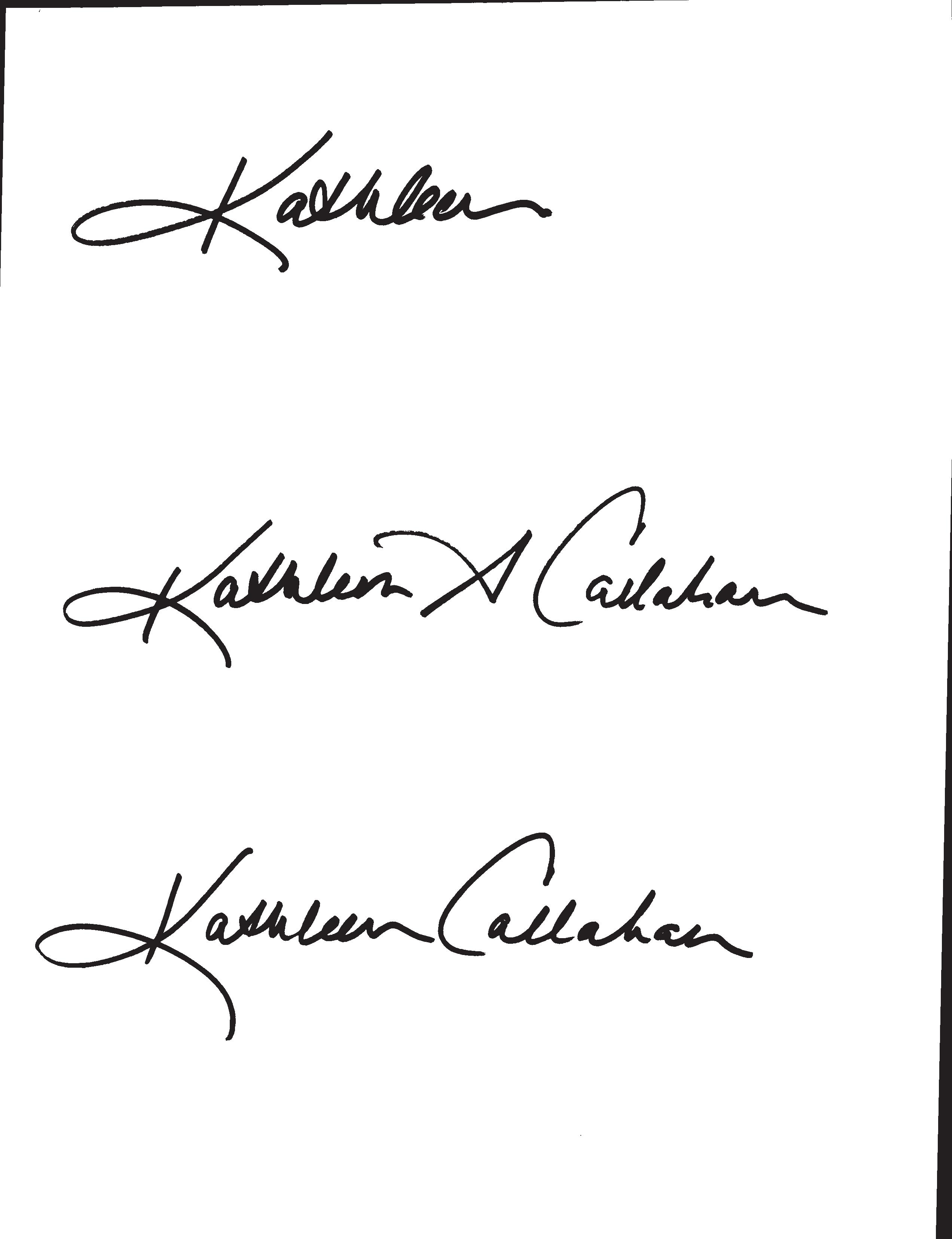
Kathleen Callahan has owned Florida’s Xpertech Auto Repair for 20 years. In 2020, she joined Repair Shop of Tomorrow as a coach to pursue her passion for developing people and creating thriving shop cultures. Callahan is the 2018 Women in Auto Care Shop Owner of the Year, nationally recognized by AAA for three consecutive years, testified for Right to Repair on Capitol Hill, and is vice chair of Women in Auto Care.
kathleencallahanfl@gmail.com
Supercharge Your Supply Chain With
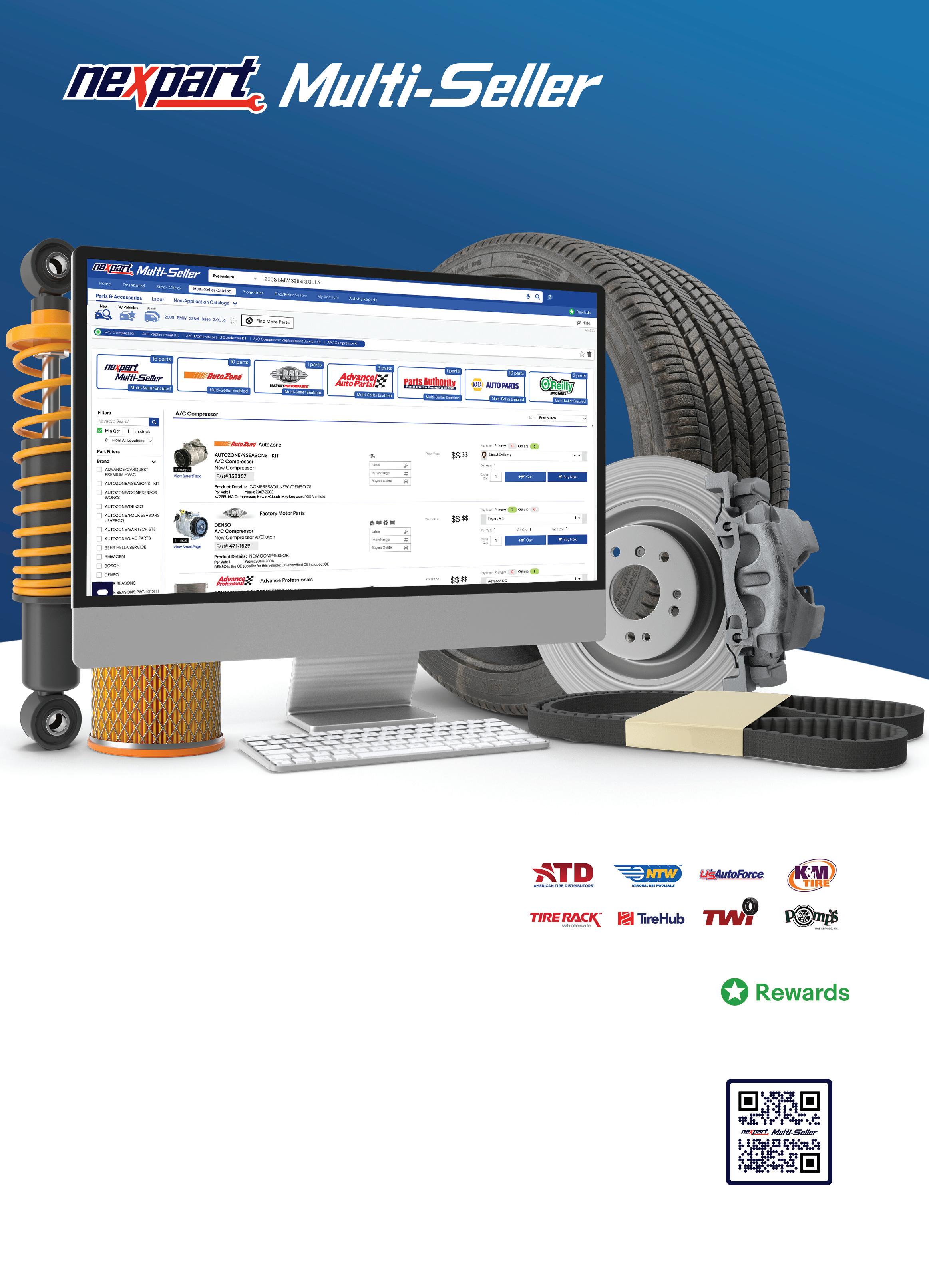
Build Estimates In Seconds.
Wit h N expar t Mult i-S el ler you’re c onne cte d to real-t ime inventor y and whole sale pricing from al l o f your par ts suppl iers. Find par ts, t ires, and more Bui ld detai le d est imates fast!
Backe d by t he most c omprehensive catalo g in t he af termarket . You’l l se e more pro ducts, from more suppl iers, g iving you more c ontrol o f your supply chain.
earn points on every parts order Multi-Seller

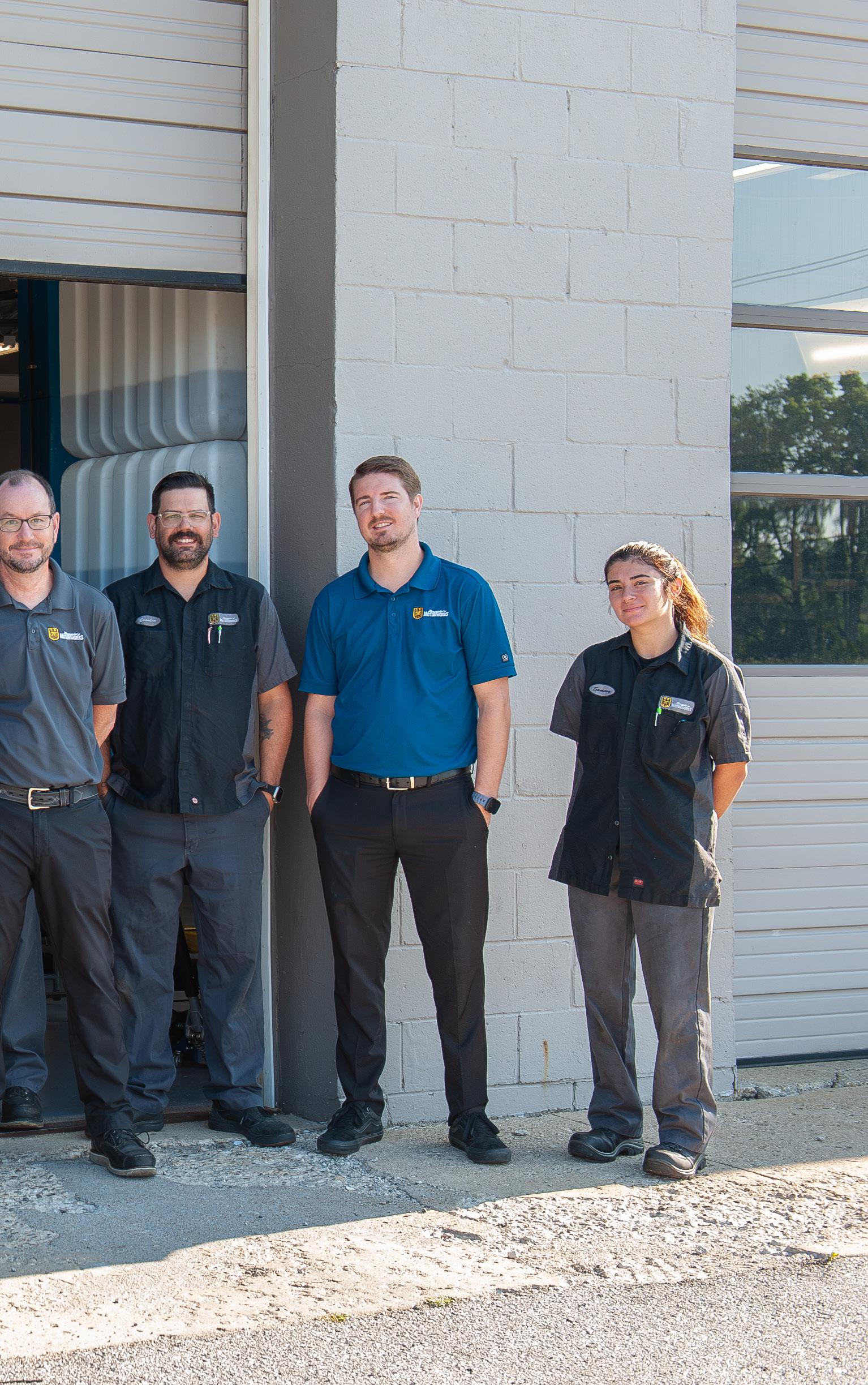
How a side hustle pushing auto parts from a pole barn grew into a $3.2 million multi-shop auto repair success story
BY KACEY FREDERICK
For Reggie Stewart, who found two areas he was passionate about in the automotive repair business, the marriage of the two wasn’t always so simple. As a business owner, there’s a lot more to a repair shop than just working on the cars. It becomes about you learning what to do so you can provide the resources needed for those repairs to happen.
With a humble, optimistic attitude, Stewart took a $1,000 loan from a friend in the early 2000s and got to work on some derelict BMWs in an old barn to sell parts on eBay. He found success in auto repair that only continued to grow, partly because Stewart took steps to keep that momentum going and built up the strongest parts of his business.
In 2006, Stewart made money working as a DJ and selling cell phones and other electronics on the side. One of his contacts, a towing company, had derelict cars that they sold at auction every week. Stewart eventually had the idea to buy an old BMW 3 Series from them, which he fixed up with his buddy and started taking to events at the local BMW club.
The parts of the vehicle they removed ended up being sold by Stewart on eBay. The online marketplace was growing in popularity at the time, and Stewart started to see potential to do something more with it.
“I knew there was an opportunity there, and I’m hardwired as an entrepreneur to look for opportunities,” Stewart says. He made a pivot, quitting his job and dedicating himself to selling automotive parts. But with little money, he needed a little help to get there.
“I’m broke—I had very little money. So, I borrowed $1,000 from my best friend, bought three old, derelict cars, and then rented half of a pole barn from another one of my old clients,” Stewart says.
Stewart got to work taking the vehicles apart himself and selling the parts online. In the cold Indiana February, in

a barn with no heat or plumbing, he was happier than ever to be embarking on a new adventure.
Within a couple of years, Stewart had sold parts to every continent except Antarctica. He was selling all over the world to clients seeking older, American vehicle parts that Stewart was able to acquire. He was also becoming close with the local BMW enthusiast community, who had been purchasing parts from him and even having Stewart install them.
Around 2009, Stewart met a technician looking for work and brought him into his
operation. Not only was he a technician, but also a former shop owner, and through him, Stewart began to understand even more about the automotive industry.
Stewart’s business kept growing and growing. By 2010, he needed to hire another technician to help, and he began to see the potential to expand the repair side of his operations. Within a year, he moved the business to a better location and began operating Reggie’s Motorworks as his new auto repair shop.
Though one technician came with him at first, he soon had to leave and left Stewart to work solo. He hired a service advisor a couple of months later, but it
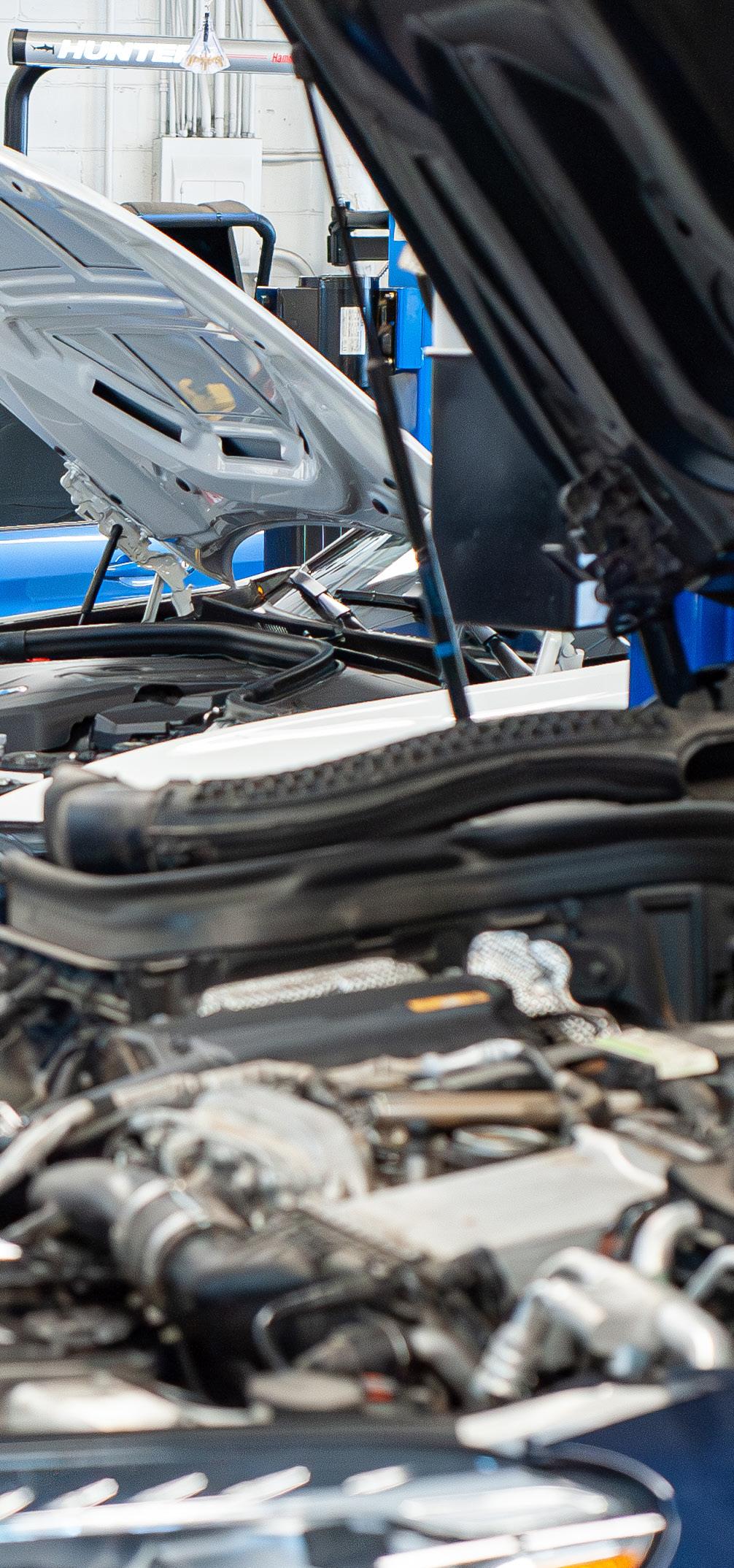
Once I transitioned to being a more higher-end, convenience-based business, life got a lot easier.”
— Reggie Stewart, Owner of Reggie’s Motorworks
would be much longer before he could figure out how all the other pieces of his business fit together.
“From 2011 to about 2015, I started hiring people, beating my head against the wall, and was figuring things out,” tells Stewart.
Things changed in a major way for him in 2015, though, once he sought out the help of a professional coach. He began understanding how to make the business more profitable and desirable for his customers and employees.
Part of that has involved him realizing that there’s much more to owning an auto shop than just working on vehicles. Much of his time is taken up by other factors that allow the business to run functionally.
When the shop originally started, it focused on vintage BMWs, but eventu-
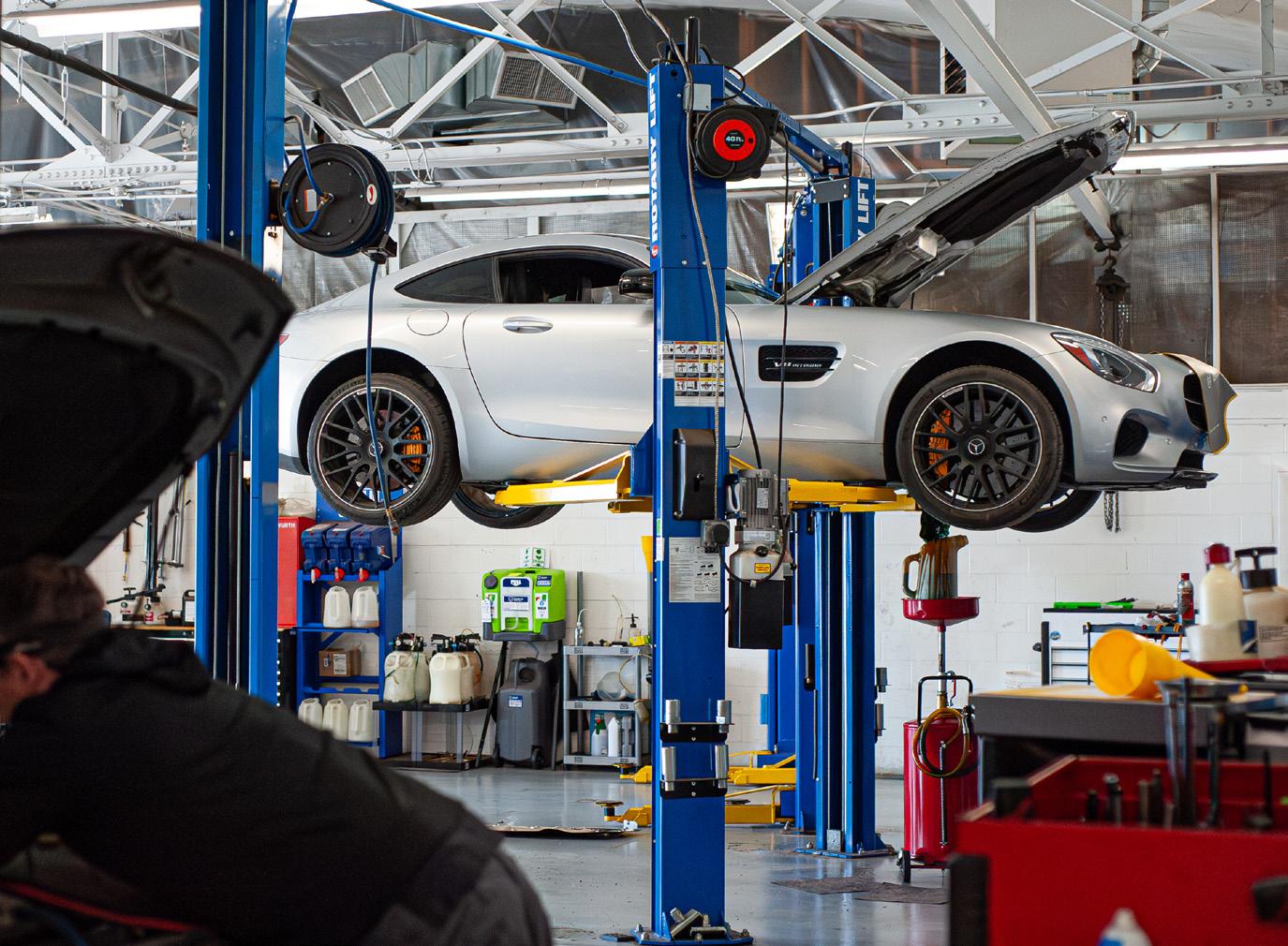
ally expanded to service all BMWs, and now works on all European models. That expansion was the result of Stewart reflecting and seeing that his customer base needed more than just vintage BMW repairs, and that his ultimate motivation was to be a successful business owner.
“I kind of follow the money, but the money is based on what people want and need the most, and what people in my area want and need the most is general maintenance and repair on late model cars,” explains Stewart. “For a while, I tried to force that restoration and performance side. And it was like pushing a big rock up a hill. There was some of that work, but it was always difficult. After working through a couple of different coaches, I finally resigned to the fact that the business that supports my family, my life, and the people that work for me is service and repair.”
Stewart’s business began to grow so much that by 2020, he rented a building next to his existing shop and made it into another shop that would service all makes and models, called The Noble Mechanic. He’s since expanded that brand to a second store and oversees a total of three auto stores.
As his business grew, Stewart had to continually reflect and challenge himself to improve. Starting as a small-time technician taking cars apart in a barn is a far cry from the $3.2 million in sales he now makes. Now that he has brand recognition, a customer base, and trust built in the community, he’s had to learn that selling at the lowest prices won’t always translate into the best service possible. For Stewart, it could sometimes mean
he would be helping low-income vehicle owners struggling to afford necessary repairs, but much of his time was spent dealing with customers who were simply looking to split hairs.
“Once I transitioned to being a more higher-end, convenience-based business, life got a lot easier,” adds Stewart.
Additionally, Stewart oversees a far bigger team of people now and has to provide competitive pay and benefits to secure the best technicians he can find.
“One of my big drivers is being able to pay my people very well and provide them great benefits. On one hand, I have to, because I can’t get quality people if I can’t compete with the big guys. On the other hand, that’s the reward for doing this work: knowing that you can support highly skilled people.
“When I have a holiday party and I
have all these people and their families that show up, and you do that group picture, and have 50 or 60 people there, and you realize that you’re the one that’s helping them all make sure they have Christmas presents under the trees for their kids—that’s when the light bulb goes off as to the power of what we’re doing.”
Like many shop owners, Stewart is driven to run a successful business because of the talent he employs, who depend on him to provide what they need to thrive. Over the years, he’s only expanded the number of people on his team across each of the three stores and has even created new roles to help ensure a healthy, vibrant company culture.
When Stewart first interviewed his shop’s marketing and events coordinator, the applicant was interviewing for a service advisor position. It wasn’t until
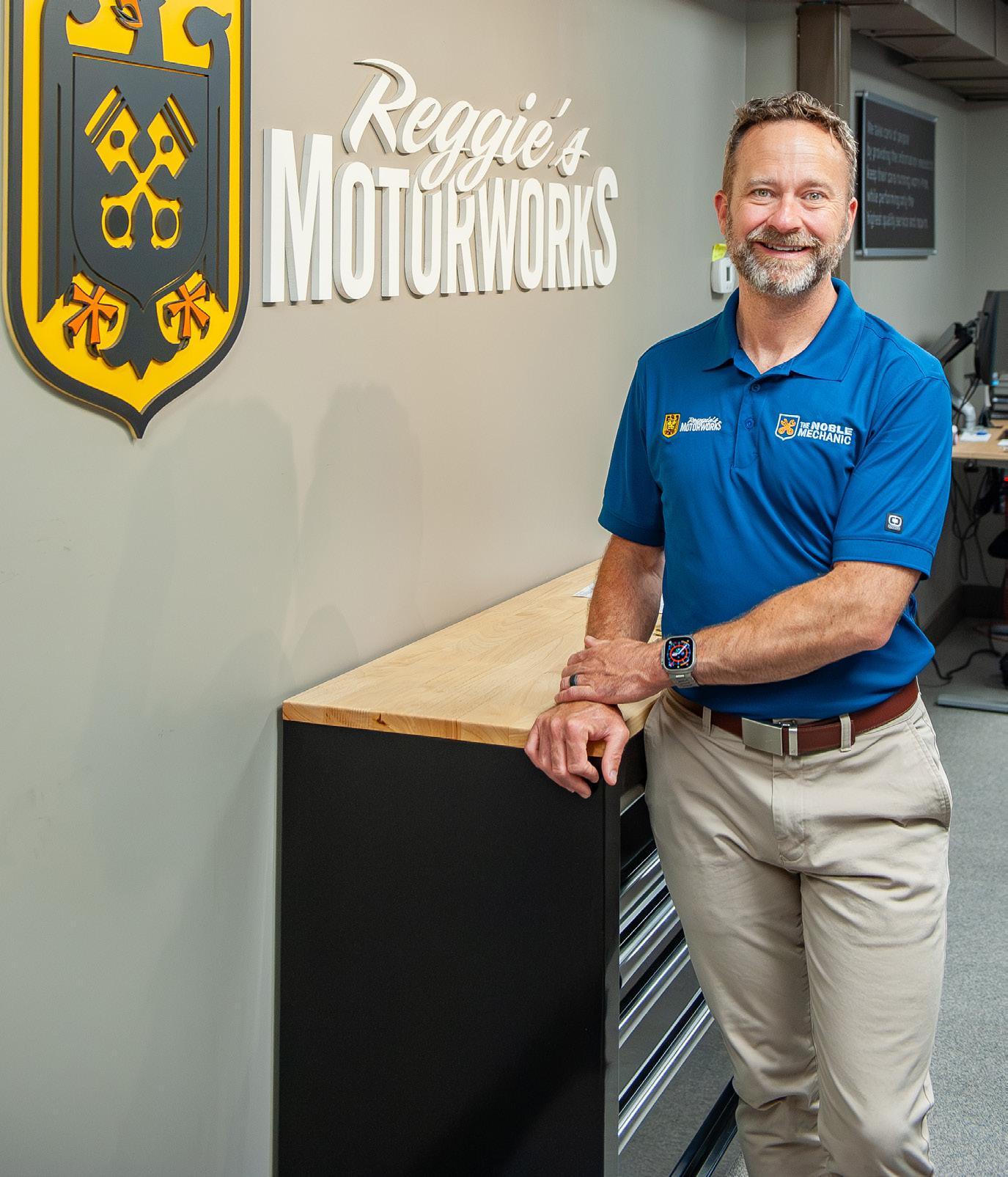
Stewart looked over his resume and saw his extensive experience in graphic design that he had an idea for how such talents could be used in his business.
“I was paying some marketing companies to do social media for me, and it was like a light bulb went off,” recalls Stewart. “I thought, ‘Man, this guy could probably do this a whole lot better than I can, and definitely better than some third party that’s not on the premises.’ Plus, he’s a car enthusiast to boot—so I basically made up a position for him.”
The result was tremendous. Stewart’s new marketing and events coordinator took over the shop’s social media, becoming responsible for creating content and keeping the shop looking nice. He’s curated campaigns including posts for employee birthdays each year, and updates recognizing staff accomplishments.
It’s been pivotal in not only boosting employee morale but also building community trust as well.
“That’s something I get a lot of compliments on from people in the community. Like, ‘Hey, it’s amazing the way you celebrate your people,’” shares Stewart. “And I’m like, ‘well, without my people, I don’t have anything.’ I’m just a guy, right? I can only fix a couple cars; I can’t do what everybody here does. So, we have to recognize them.”
On top of that, the marketing and events coordinator has implemented internal communication throughout all three of Stewart’s shops through Microsoft Teams. Employees often wish one another a happy birthday or anniversary through the platform, which further solidifies the bond between team members.
The success of Stewart’s shop has all resulted in him fully realizing his role as a shop owner. Even better, he now has enough time to pursue his passion for working on vintage BMWs in his own spare time.
He has it all, but it was only possible through humility and a willingness to surround himself with others and learn from them.
“Once you start your shop, keep talking to successful shop owners. Because if you’re humble, coachable, and willing to learn, your progress is going to happen so much faster than if you jump into it thinking you already know everything,” says Stewart. “Be a sponge.”





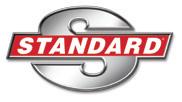






























































Robin Reneau is proving that auto repair isn’t just about fixing cars—it’s about building community, confidence, and careers
BY ALISON JOHNSON | PHOTOS BY MAX SMITH

AS A YOUNG SINGLE MOTHER, Robin Reneau scraped together money for three different cars in four years, all of which experienced major engine or transmission failure within two years. Two didn’t even last a year.
In one case, Reneau bought a car with an already–dying transmission because she didn’t know how to use a dipstick to check for black, gritty fluid. Another vehicle had an undetected oil leak, and she didn’t recognize the noises of a failing timing belt in the third.

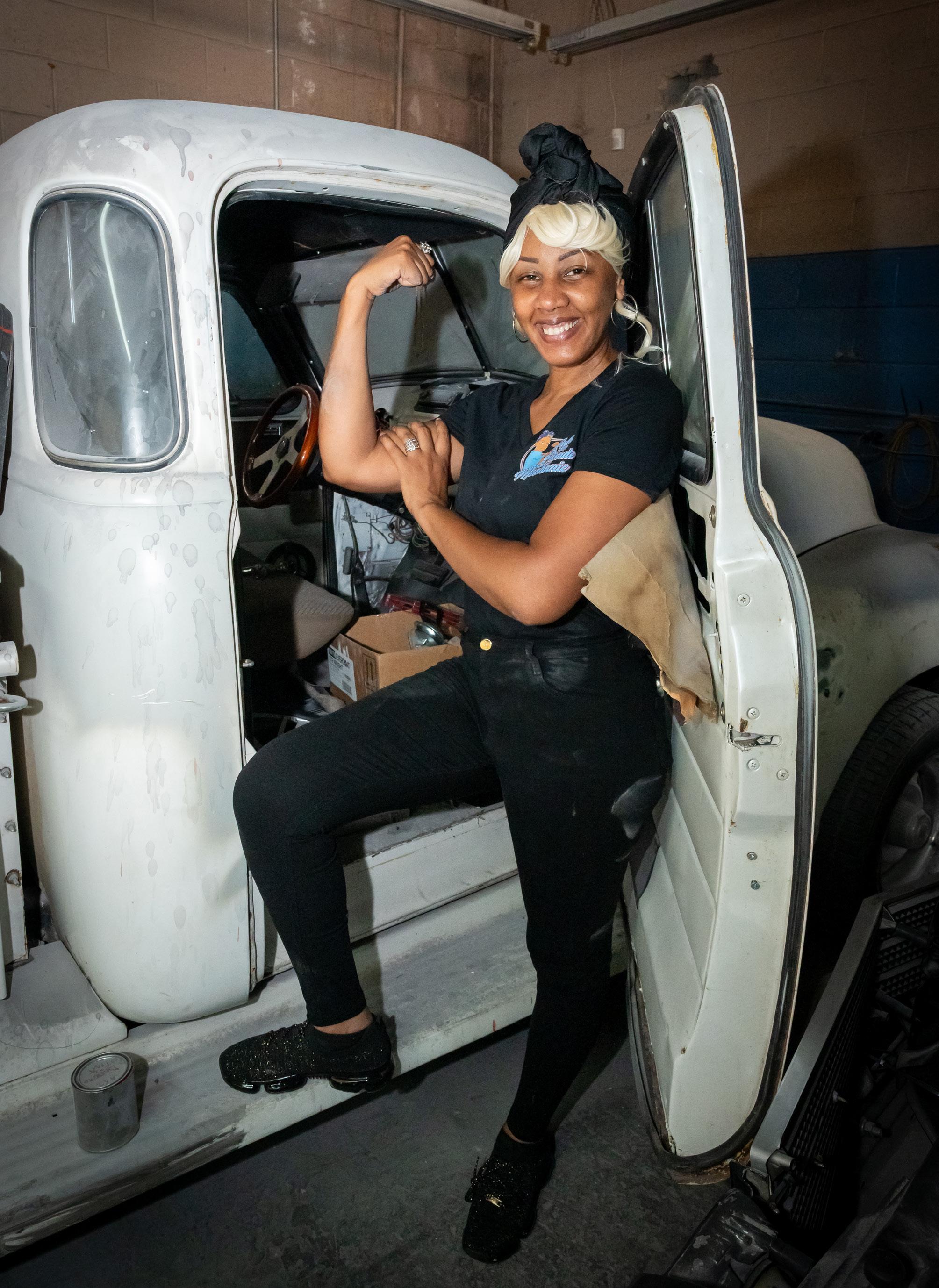

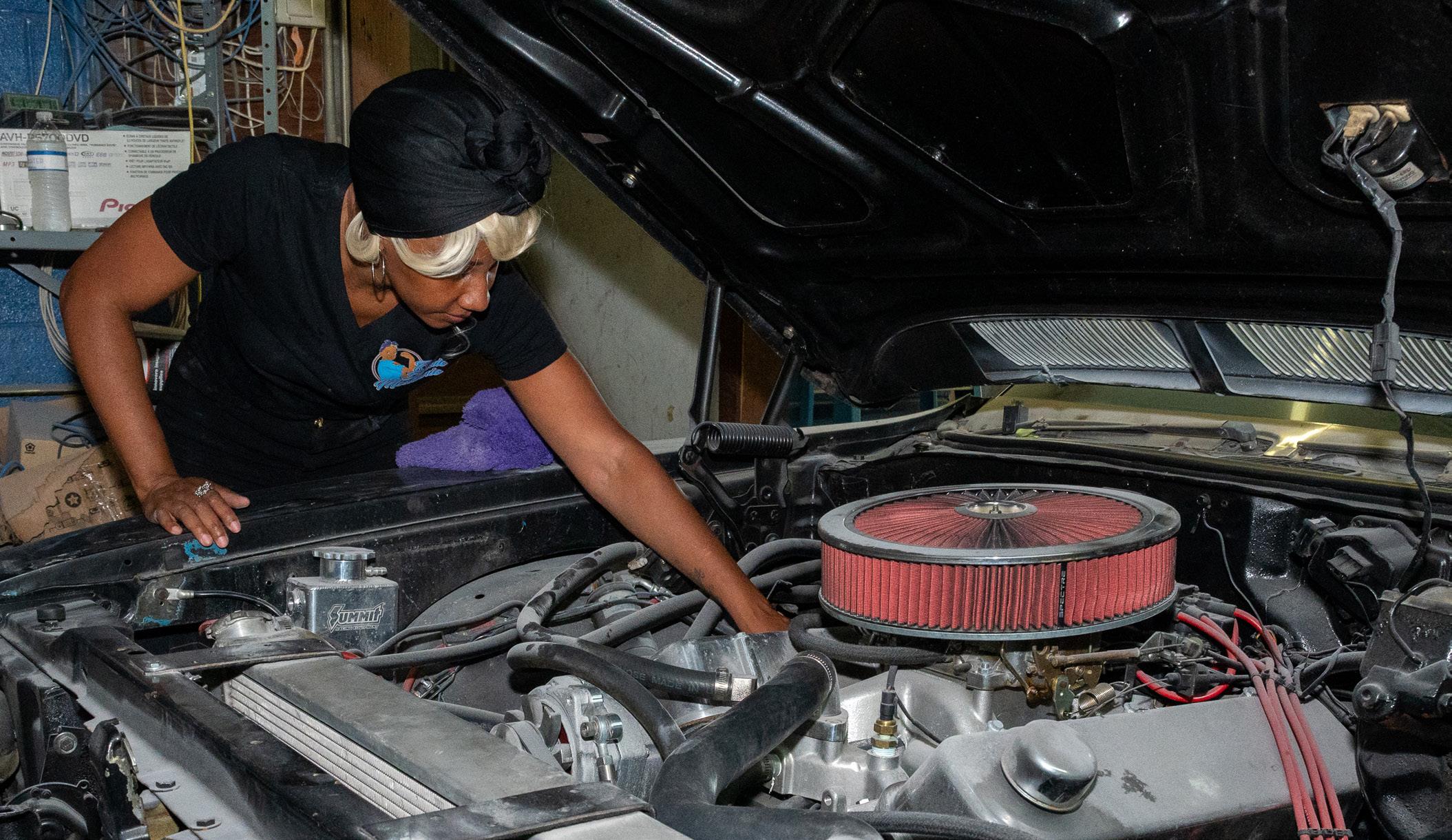
“I kept ending up right back on the bus,” she says. “I was completely clueless. I once drove on a donut spare tire for a month until it finally popped, and I threw away the original flat tire still mounted on its rim because it took up too much room in my trunk. Something had to change.”
But Reneau, a high school dropout who had the first of her five children at age 16, would have laughed at the thought that a few car lessons from knowledgeable friends and neighbors would lead to her running her own automotive shop.
In 2020, Reneau founded her business, Rob The Blonde Mechanic, LLC, after spending 16 years working her way up from receptionist to service advisor, lead tech, store manager, and ultimately district manager for a major retailer. She was the first Black woman mechanic to own an independent repair shop in Georgia, according to her website.
“Representation matters,” she says. “Me—I wasn’t supposed to win. But I did, and now I know that part of my purpose is to show others what’s possible and to empower them. If I can turn my life around, anyone can.”
Reneau, 41, originally called her business Georgia Auto Solutions —“a basic,
safe name”—but after her first husband dubbed her “The Blonde Mechanic” because of her blonde mohawk and the nickname stuck. She officially changed the company’s name last year, going with “Rob” rather than “Robin” for people still more likely to contact a shop they assumed is run by a man.
Rob The Blonde Mechanic currently does about 90% of its work on a mobile basis—with an optional subscription service with member benefits—after closing its first brick–and–mortar location and acquiring another building to renovate. That new site in Atlanta should be ready this summer, growing the business to 10 full–time employees.
As a nod to her own unimpressive past with cars, Reneau likes to offer free auto care workshops and educate do–it–yourselfers on safely managing basic repairs. New clients also get a handwritten thank–you note welcoming them into her company’s family.
“While many shop owners talk about their passion for cars, my passion has always been for people,” she explained. “I truly believe I’ve been called to serve, and I just happen to do that through automotive repairs. Our shop isn’t just a place to fix
cars to me. I want it to be a space where people feel seen, supported, and valued.”
Born in North Carolina, Reneau wanted to be a model, teacher, or rapper as a child. All she knew about cars was that she liked the ones with shiny paint, working radios, and air conditioning systems.
As a teenager, Reneau was living in New York and going down a troubled path when she left high school as a 15–year–old sophomore and soon found out she was pregnant. Her parents divorced when she was 2; her father was absent for years as he struggled with substance abuse.
After moving to Atlanta for a change of scenery, Reneau was working minimum wage jobs and relying on government assistance programs until she landed a well–paying position as a front office manager for a medical practice.
Yet by then, Reneau had discovered she enjoyed working on cars and began to consider making a run at a new career. Her family and friends thought she was crazy, except for one unlikely person: Her dad, who had slowly rebuilt their relationship after getting his life together.
“He was like, ‘Yeah, girl, you go for it!’” she says. “Thankfully, he was the person I listened to.”




In 2004, Reneau became a receptionist at an auto shop and learned on the job as she moved into various roles. She often volunteered to hold a flashlight for shop technicians as they made repairs and listened as they talked to each other and customers.
With a GED under her belt, Reneau earned a degree in automotive technology from Georgia Piedmont Technical College, followed by numerous certificates. She has worked steadily outside of a short break to help care for her mother as she was dying of cancer.
Building confidence in a male–dominated industry was the biggest challenge for Reneau, as was staying true to herself. She had never seen a Black entrepreneur or business owner as a child and repeatedly heard that she was “too much”—too bright, too bubbly, too feminine.
Managers commented on her fashion choices and told her that pink didn’t belong in a shop. They called her personality “distracting” despite having no issues with her actual work. However, an automotive instructor with pink hair, manicured nails, colorful lipstick and an “I don’t take no crap” type of energy convinced Reneau she didn’t have to change.
“It took a lot of strength to stop shrinking myself to fit into spaces that weren’t designed for me or anyone who looked like me,” Reneau recalled. “Now, I lead with confidence and authenticity, because I’ve learned that being different is my superpower.”
Reneau has aimed to make her shop a welcoming spot for people of all backgrounds, including customers from Atlanta’s large LGBTQ community. She has also become a motivational speaker and writes a blog with practical tips for car owners.
Moving forward, Reneau is preparing for a major industry shift facing all shop owners: the rapid adoption of electric vehicles, advanced driver assistance systems, and increasingly complex onboard electronics.
Serving such vehicles requires not only specialized tools and diagnostic equipment, but a deep understanding of high–voltage systems, battery management, and manufacturer–specific protocols, Reneau notes.
“In the next seven to 10 years, we expect a large number of independent shops to close due to a failure to adapt,” she says. “As the internal combustion vehicle population declines, relying on legacy repairs
will no longer be sustainable.”
Reneau now requires her technicians to complete at least 40 hours of advanced training annually, with a strong emphasis on EV systems, diagnostics, and safety procedures. She also attends industry conventions and technical expositions to keep up with emerging trends.
On the equipment side, the shop’s next major investment is an ADAS calibration system, and Reneau is budgeting for high–voltage safety equipment, EV service bays, and OEM–compliant scan tools as well: “Our goal is to be fully capable of supporting both legacy and next–gen vehicles, positioning ourselves as a future–ready, full–spectrum repair solution.”
Outside work, Reneau is married with kids ranging in age from 13 to 24, plus eight stepchildren ages 17 to 30, an 18–month–old grandson, four step–grandchildren ages 2 to 10, and a 5–year–old chihuahua. She counts gardening and rollerblading as hobbies.
More than two decades into her unexpected career, Reneau is grateful she took a chance on a wild dream. “It’s been a joy,” she says. “It hasn’t been easy, but now we’re just rocking. We’re rocking and we’re rolling.”
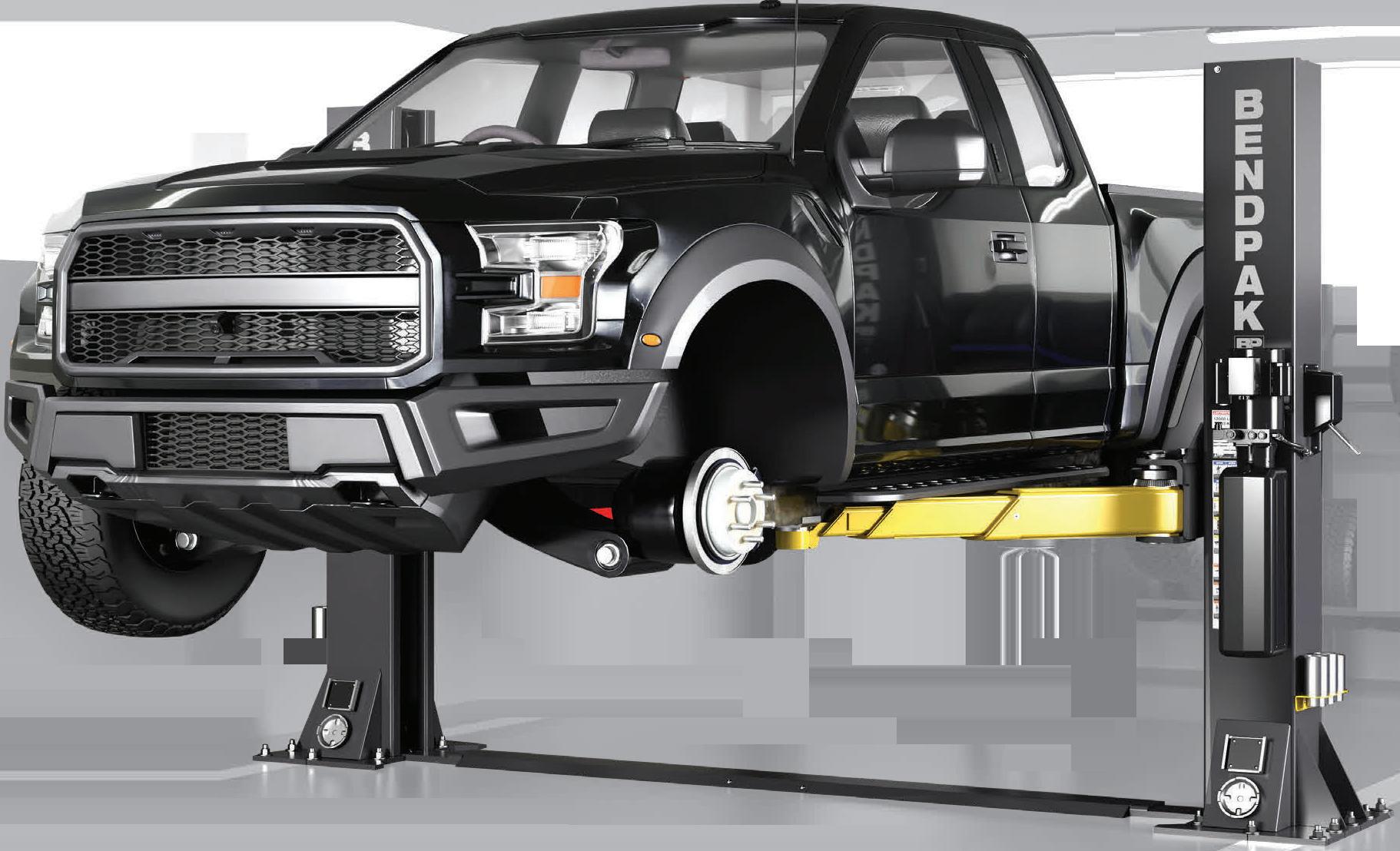





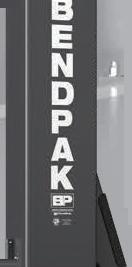
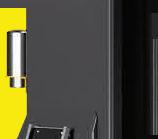



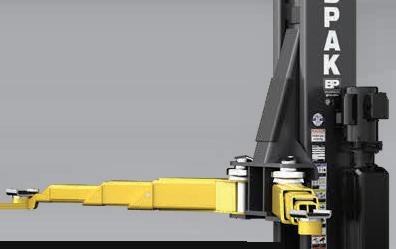
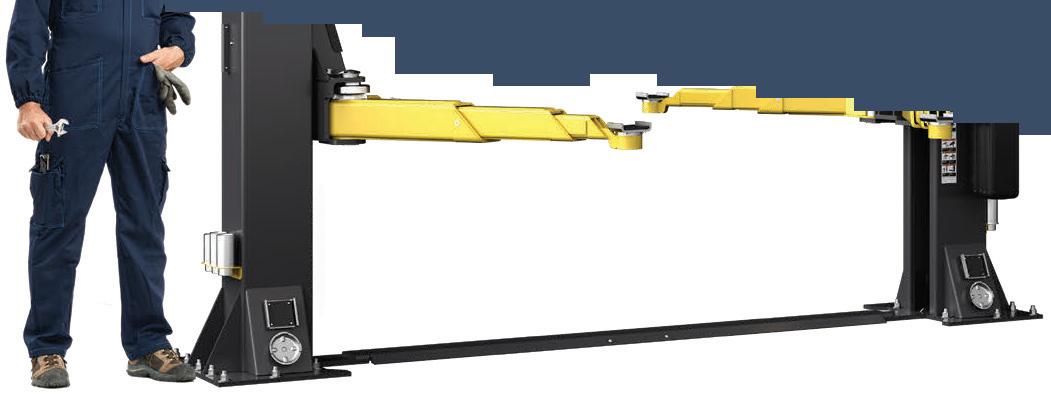


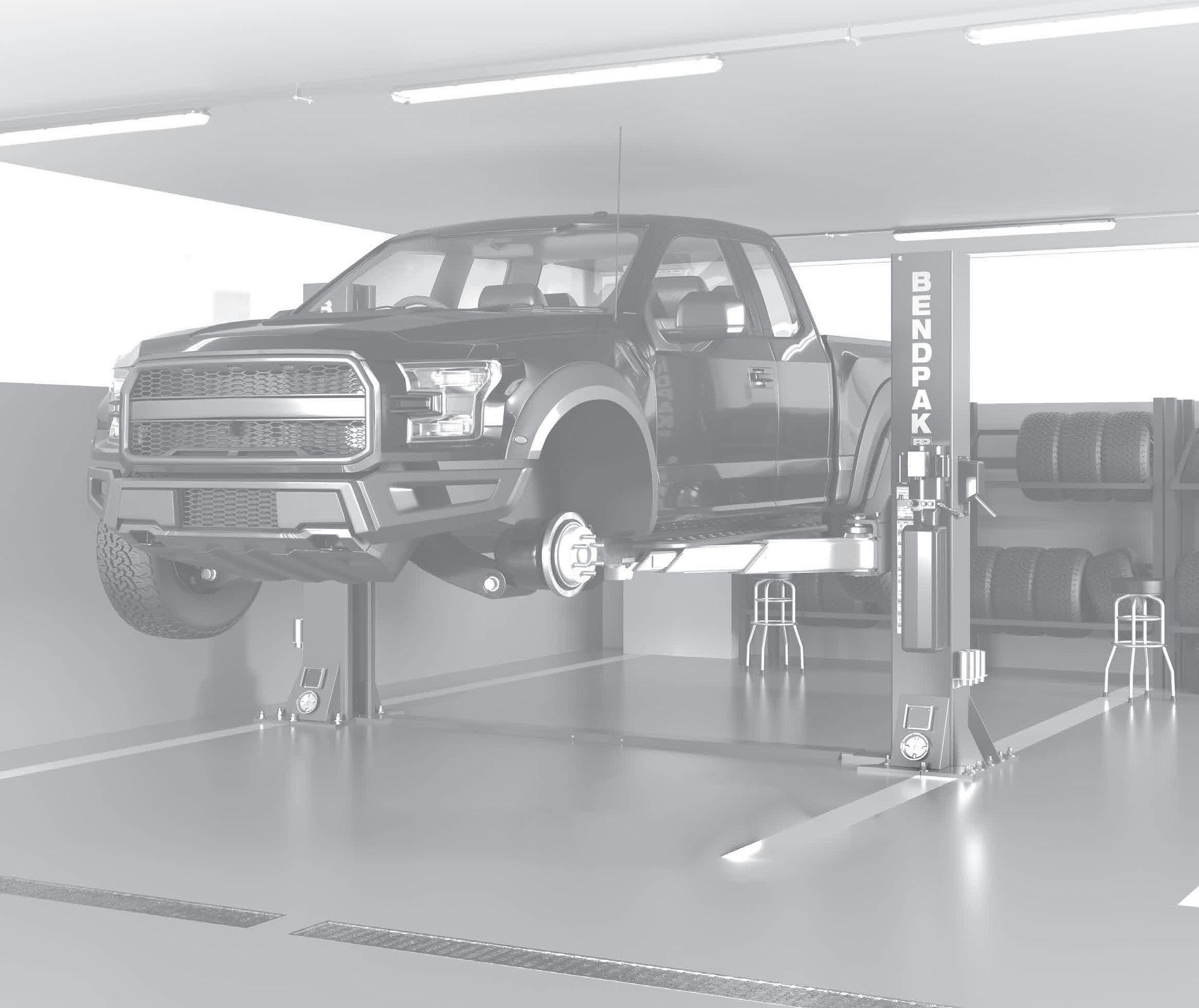

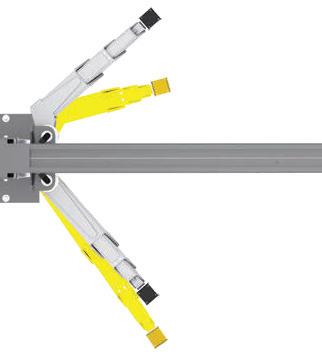


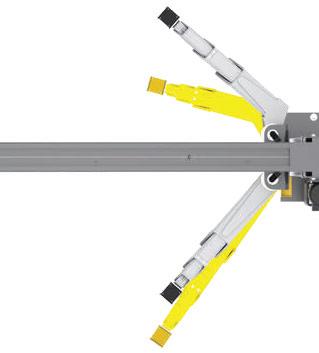





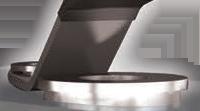
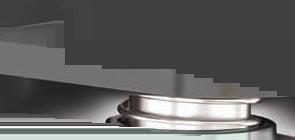


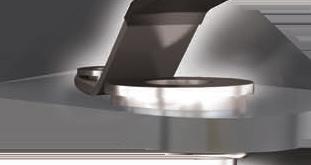



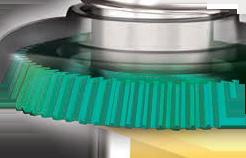
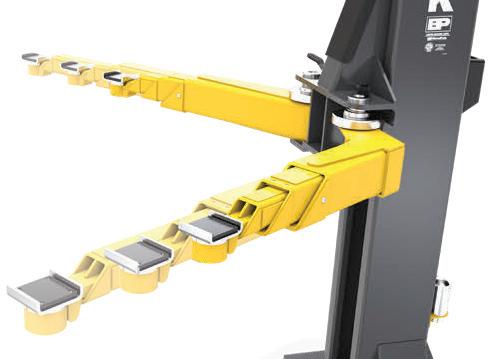





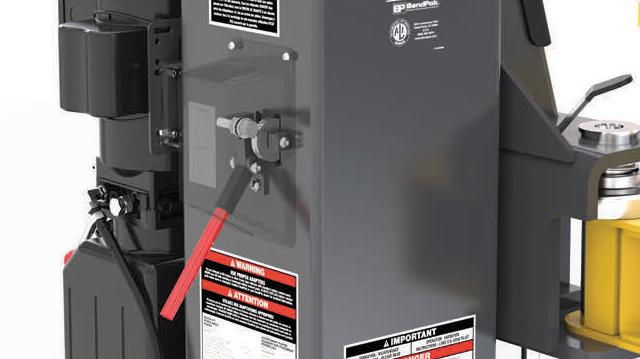
The BendPak 12AP-SRT short-rise two-post lift cost-effectively improves tire shop productivity and efficiency while mitigating risk. With 12,000 pounds rated capacity, massive wingspan that reaches most OEM lifting points, and BI-METRIC™ arms to suit virtually every vehicle lifting requirement – symmetric or asymmetric. The 12AP-SRT can raise 99 percent of cars, SUVs, and trucks to a comfortable working height much faster (and easier) than a set of jacks. Its single-point safety lock system, super-strong automatic arm restraints, and limited max lifting height of 47 inches deliver superior peace of mind. The short 93.5inch columns offer lower product, installation, and maintenance costs, plus a cleaner floorplan. Check out the full line of BendPak lifts at bendpak.com or call us at 1-800-253-2363.





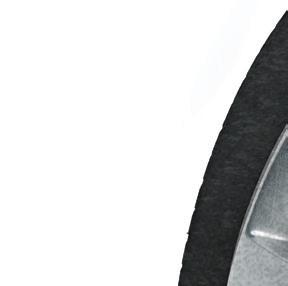
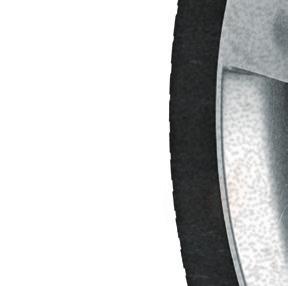
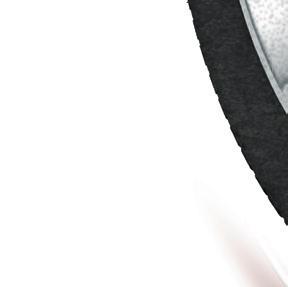

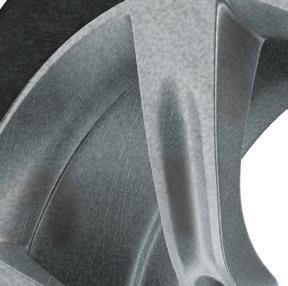
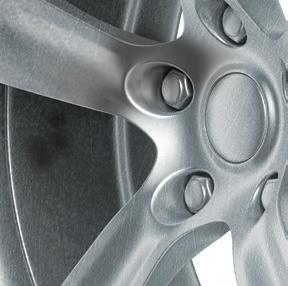


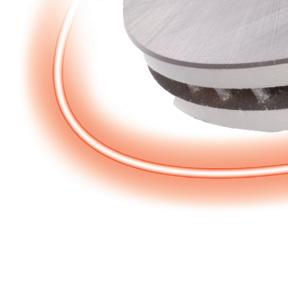

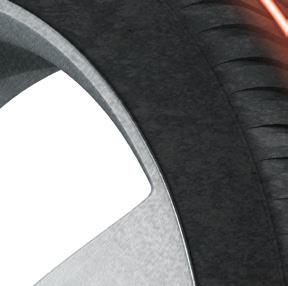
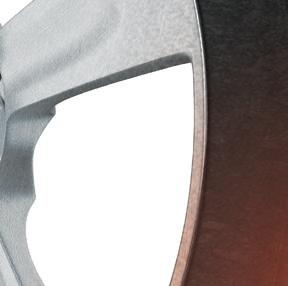

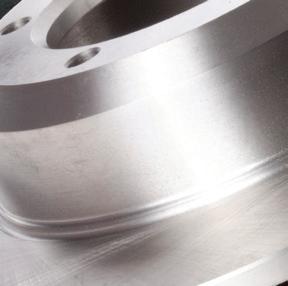
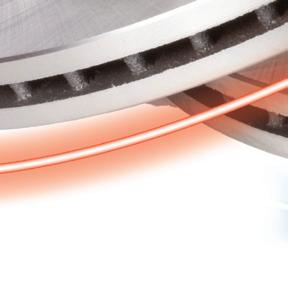


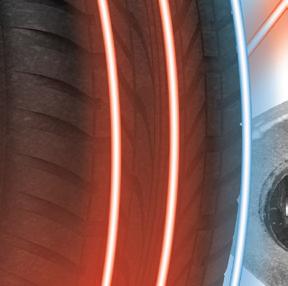
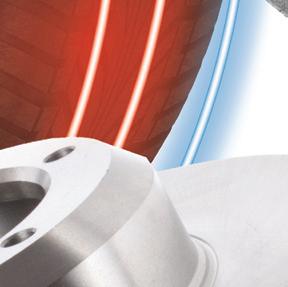
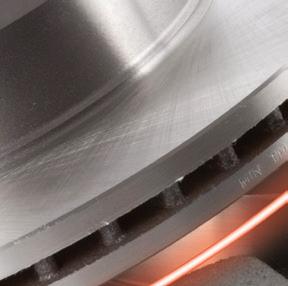
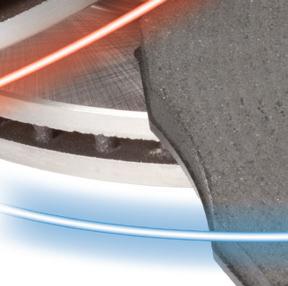


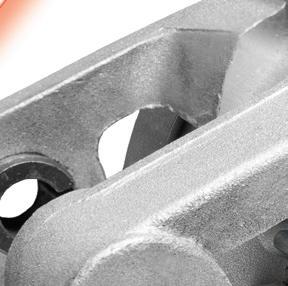

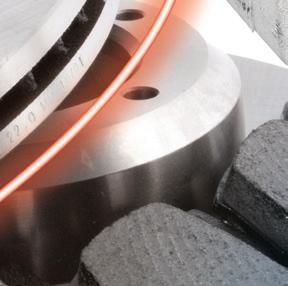
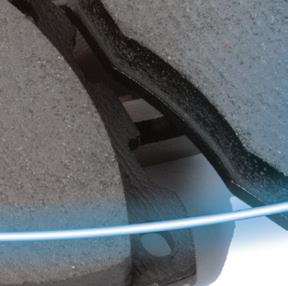


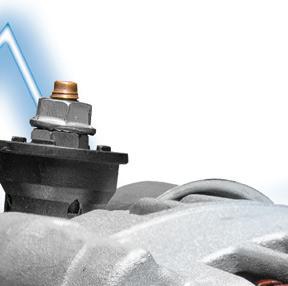
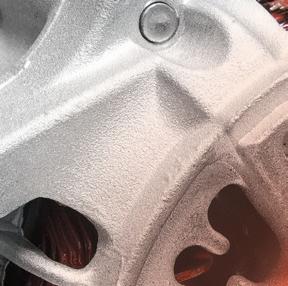

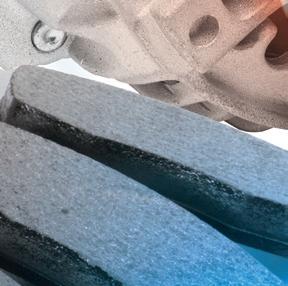
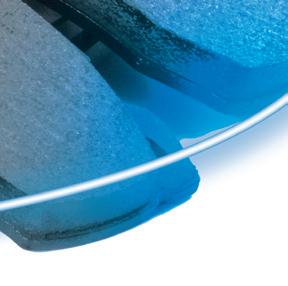
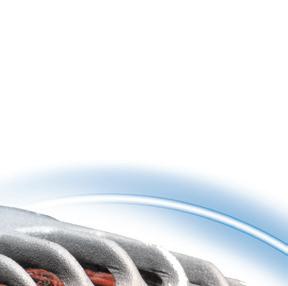
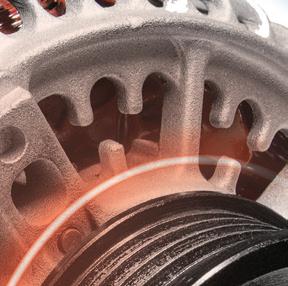

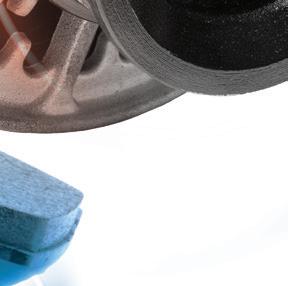



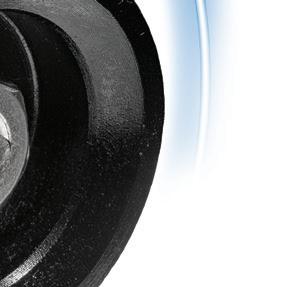


Burnout is a common phenomenon in most shop environments, and a check engine light you don’t want to ignore
BY NOAH BROWN
A recent study highlighted by Forbes shows that two-thirds of employees in the country experience some form of job-related burnout. There are many contributing factors, but they all result in lower productivity and job happiness. Heather Williams, co-owner of Xcel Service and Repair in Stonewood, West Virginia, says the automotive repair industry is no different when it comes to employees feeling burned out.
“It’s more prevalent than anybody gives credit for. All of us go through it at some point in time,” Williams says. “It’s just a matter of how extreme it is and if it’s well-managed.”
Margaret Light, a Minnesota-based licensed therapist who specializes in serving clients from the automotive industry, says that burnout operates on a spectrum, and every single person falls on that spectrum somewhere.
“It’s not necessarily a question of does someone have burnout or not? It’s a question of what level of stress do they have and has it progressed into burnout?” Light says. “Everybody has baseline stress, and then as responsibility increases, stress increases.”
Burnout can have a major negative impact on your ability to perform your daily responsibilities. Identifying your level of
burnout, understanding how it affects you, and learning methods to mitigate stress can greatly benefit your personal health and the health of your shop.
Williams says most folks in the automotive industry take a tremendous amount of pride in their ability to multitask and operate under stressful situations. Though that may seem like a virtue, it can wear down your body, which can hurt you in the long run.
“Most people do have a lot of pride, and they won’t even own the fact that they are overly stressed, which leads to
burnout,” Williams says. “You’re running yourself ragged doing three, four, five jobs, and that’s exhausting. Your body is physically breaking down.”
Burnout is a clinically recognized problem, and Light says three hallmarks are usually present in a person when they are burned out. Recognizing these in yourself or someone you work with can be a helpful first step in helping combat overworking yourself. The first is overwhelming exhaustion . People dealing with this may feel like even small tasks are overwhelming and impossible to complete, and it may seem like they are “giving up.”
The second is cynicism and detachment from work. This will come across as people seeming disinterested, withdrawn, or otherwise disillusioned with their job.
Last is a sense of reduced personal efficacy. This will show up as people thinking that their work doesn’t matter, which will result in them failing to meet even the bare minimum in their work.
Light says that, since burnout is a
spectrum, people may only show one of those symptoms, or they may show all three, and they may show up in varying degrees of severity.
“There’s going to be a combination of internal experience and then external behaviors,” Light says. “External behaviors could vary. It could be someone who’s really irritable, it could look like no motivation and lack of follow-through. And in some really severe cases, people just stop coming into work altogether.”
Williams says burnout can have symptoms very similar to depression, and people dealing with severe burnout may begin to lose sleep, become unmotivated, and be at higher risk of health problems.
“Sometimes you do need to have either a mental health professional or a doctor of some sort to evaluate you to make sure that the burnout isn’t causing other problems,” she says.
Letting burnout go unchecked can be a major detriment not just to your personal health, but to the health of your shop.
Light says that once burnout begins, it continues to build over time.
“It’s not something that will resolve on its own, and it doesn’t stay the same,” she says. “It gets worse.”
She also points to research that shows that people are more likely to become burned out themselves if they work with someone who is burned out. Because of that, it’s in your best interest and your shop’s best interest to help people dealing with burnout, whether that’s yourself or one of your employees.
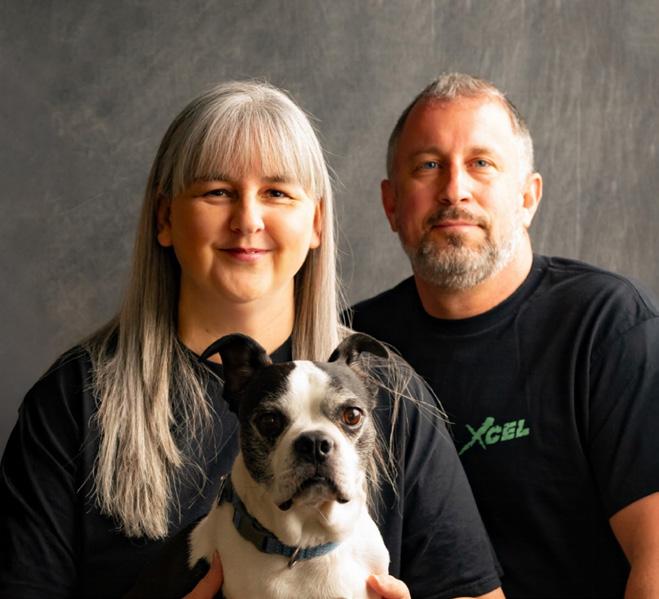
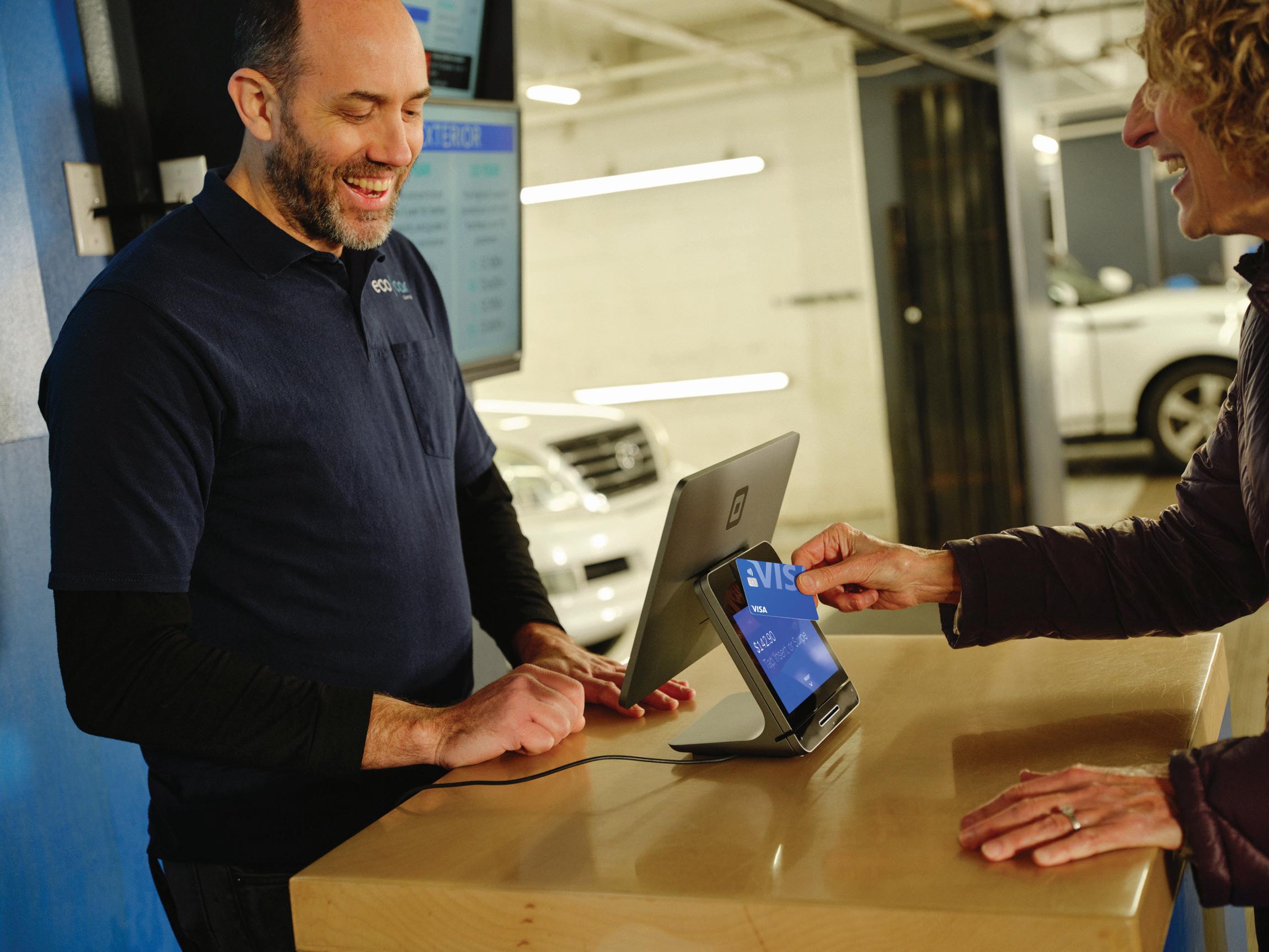
Williams says that the first step owners and managers need to take in dealing with their burnout is to learn to say no and delegate. Delegation isn’t a new concept, but building trust with your team and allowing them to take on more responsibility can help lighten your load.
“That’s something, especially as shop owners, we don’t like to ask for help,” she says. “But that is very, very important.”
She also recommends figuring out ways to make small adjustments in your

schedule to allow for a little more personal time. It doesn’t have to be much— 15 minutes added to your lunch or a half hour on Fridays when you’re able to leave a little earlier —but giving yourself a little space to breathe and unwind can go a long way.
Another crucial element is taking care of your physical health. Burnout expresses itself in physical symptoms, which means that your body will deteriorate from excessive stress. Getting enough sleep, eating right, and exercising enough are essential to helping your body recover.
Williams also says practicing selfcare and doing things that are restorative for your mind and body is the best way to reverse burnout.
“That’s going to be different for everybody, but maybe it’s going to the lake, reading a good book, going camping, hunting, fishing, whatever it is that you like to do,” Williams says. “You need to practice self-care and get in the habit of doing something you like to do that’s not related to your job.”
Light agrees with the need to practice self-care, adding that spending time with friends and family, journaling, and finding hobbies outside of work can be a great benefit and can build a support network that helps maintain your mental health. However, in more severe cases, self-help may not be enough to mitigate burnout. In those instances, Light strongly recommends seeing a mental health professional to help you deal with the symptoms.
Burnout is prevalent throughout the workforce and can be detrimental to a shop’s culture. Learning to identify it and properly deal with it is essential to running a smooth operation. Light says acknowledging that you may be burned out and asking for help if you need it is the best thing you can do for yourself and your business.
“You need to give yourself permission that it’s OK to not have it all together once in a while,” Light says, “and we need to take burnout seriously early, because life doesn’t get easier as it progresses.”
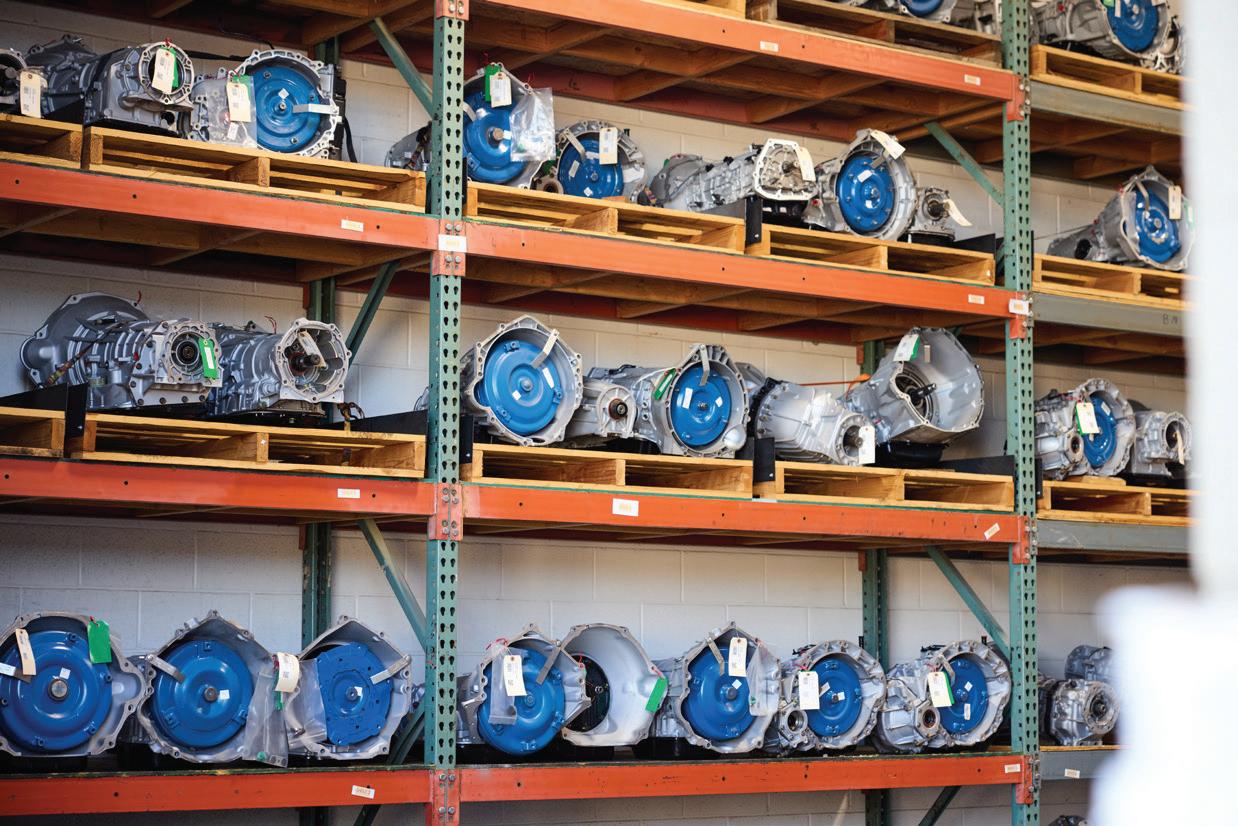

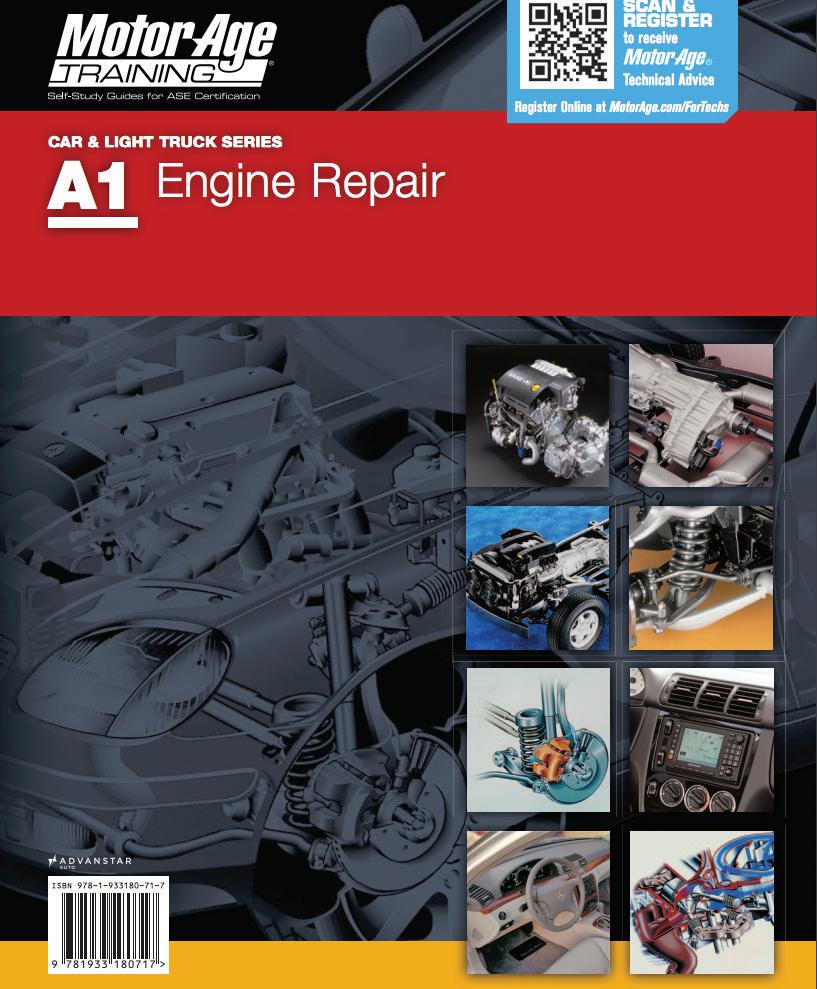

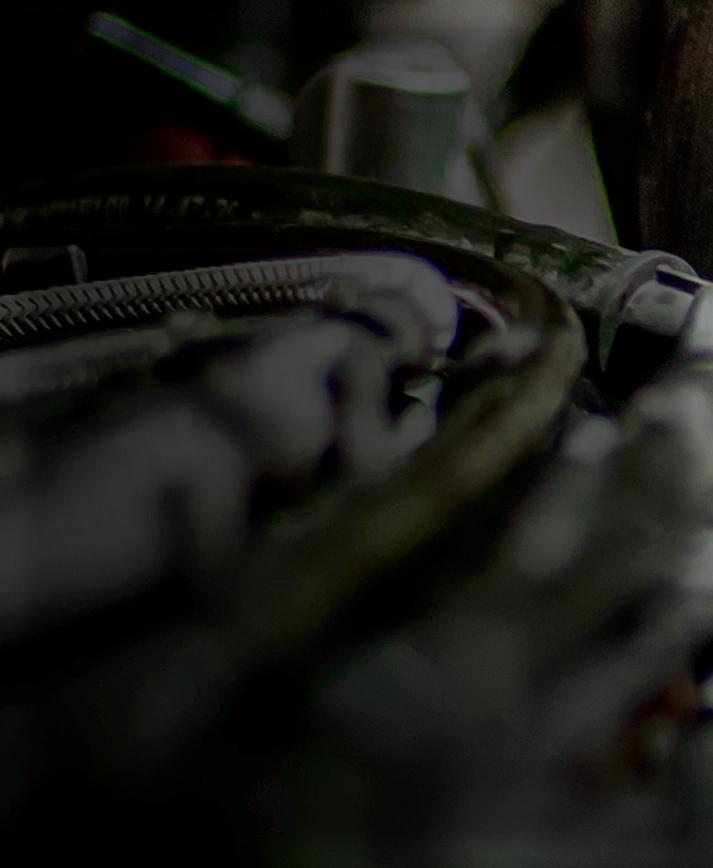


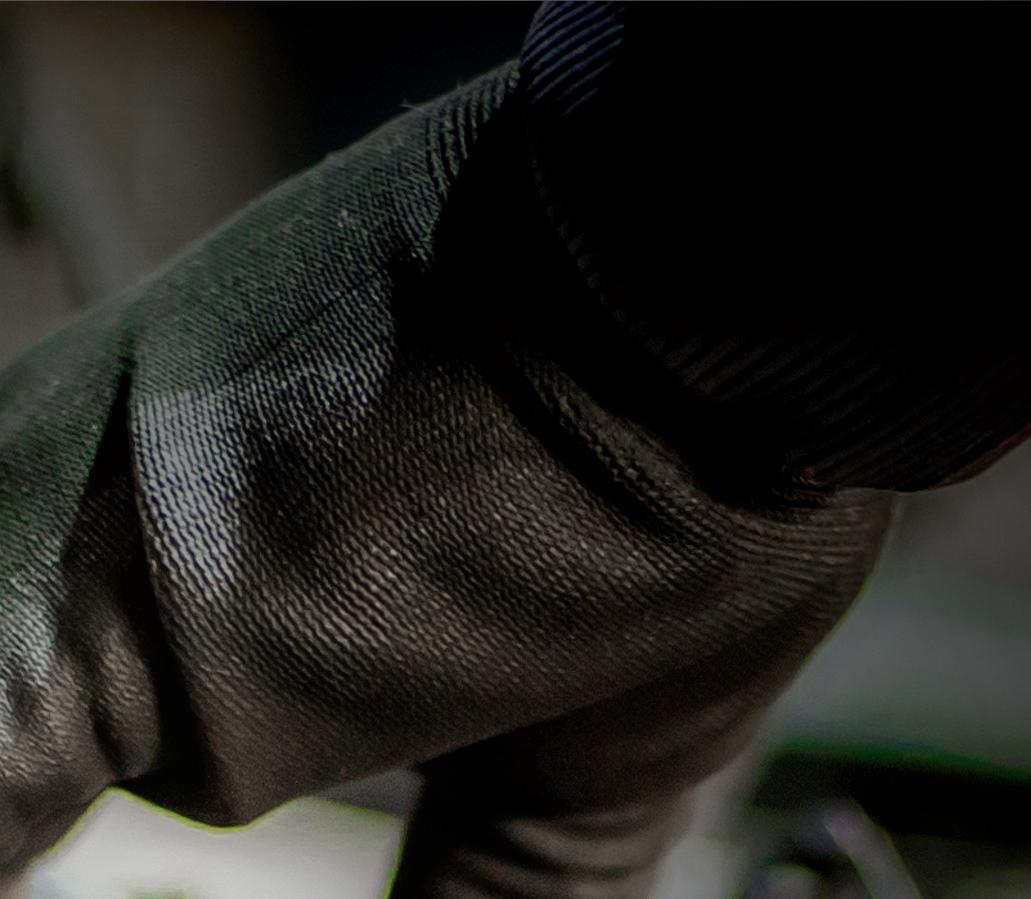
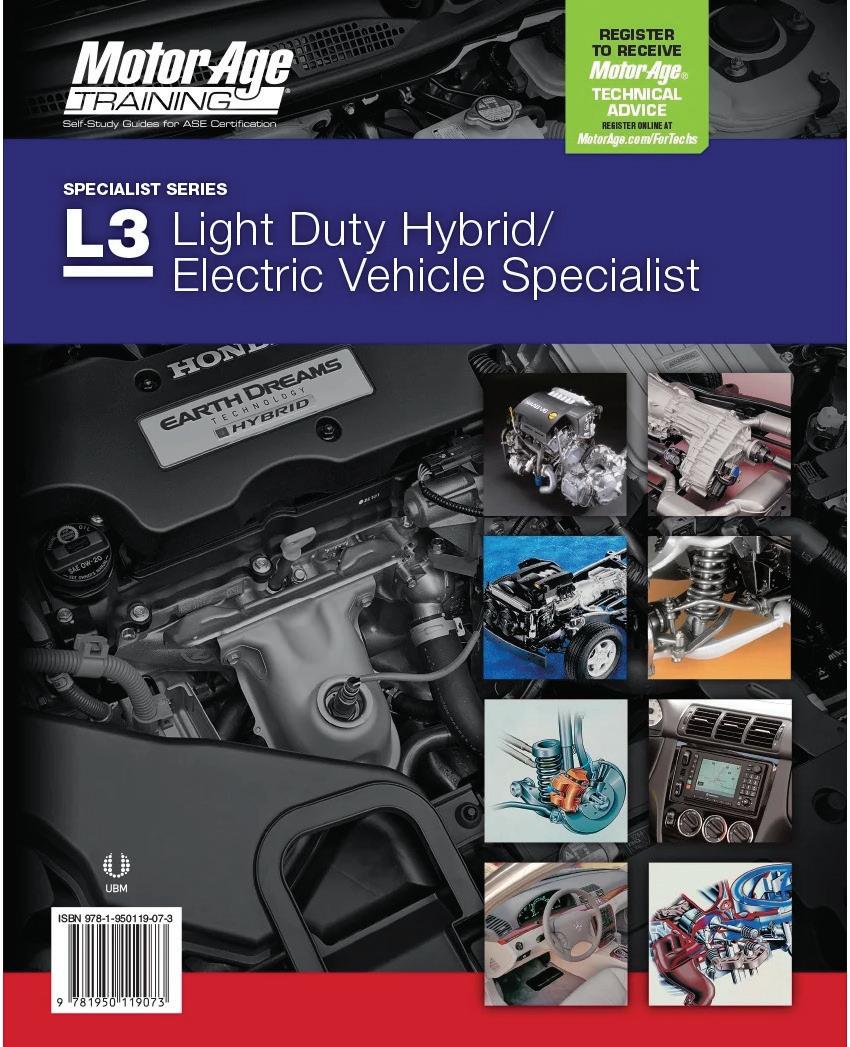
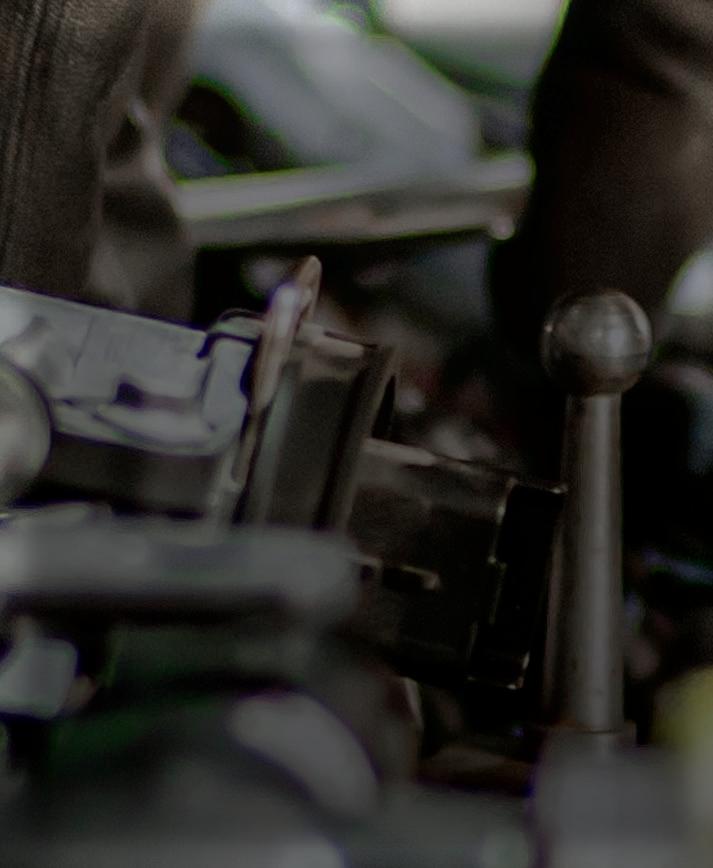





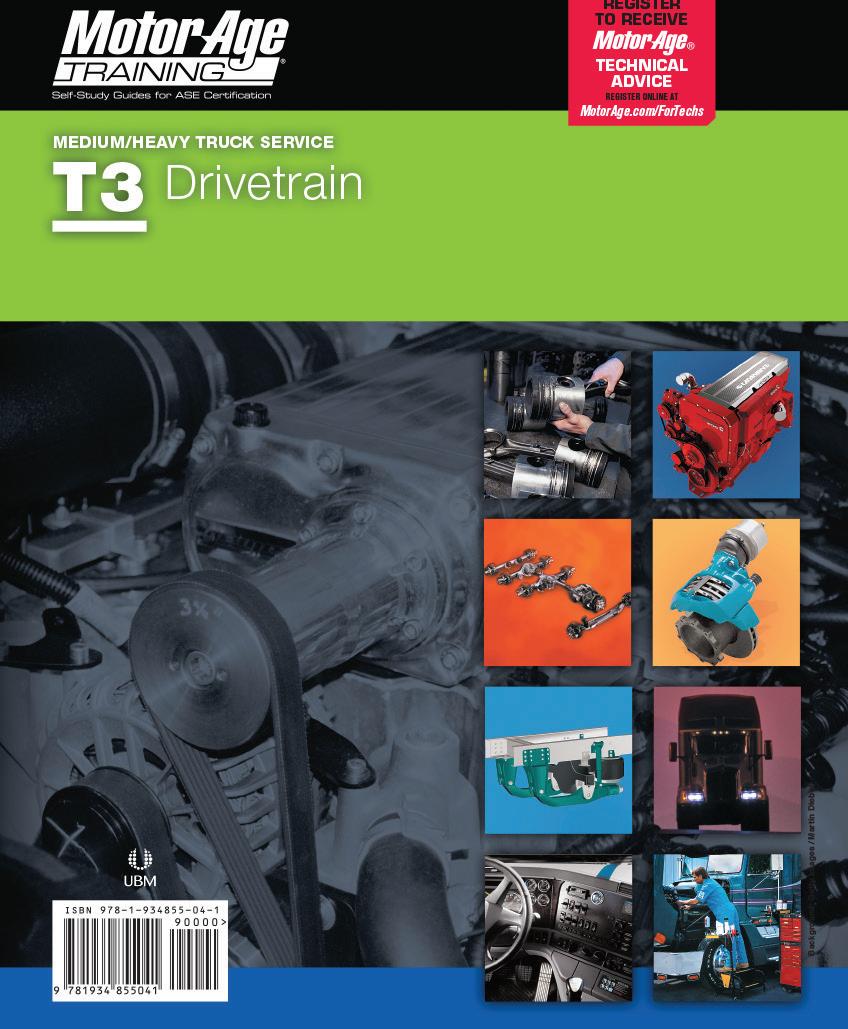

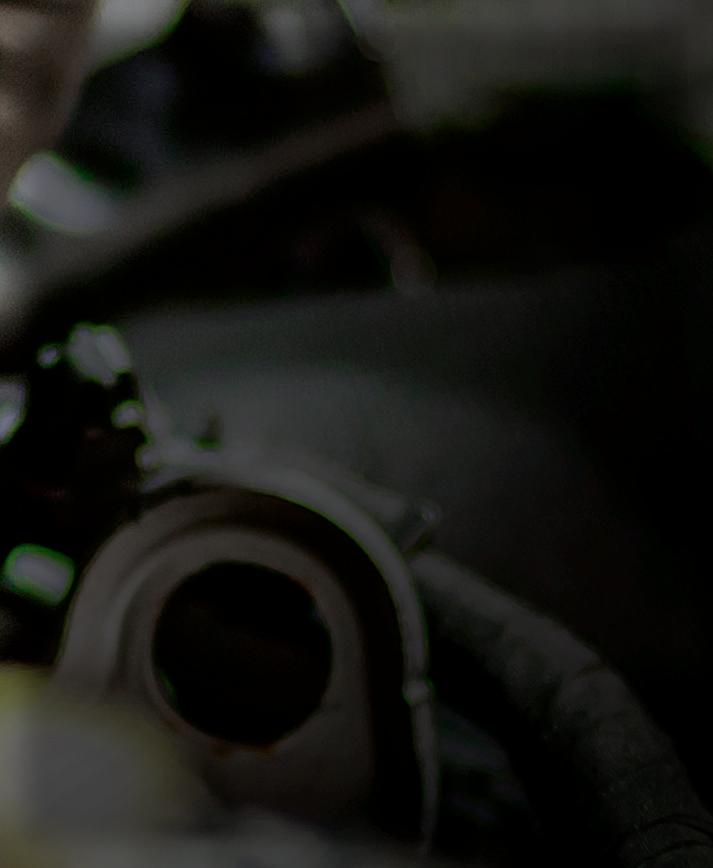



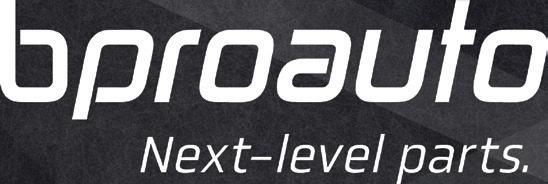




How Shadetree Automotive’s Tom Lambert revived a struggling shop he acquired and made it profitable
Since 1931, A.B. Hadley has been a part of Ogden, Utah’s story. For three generations, the auto repair shop has been serving the community and going above and beyond to help those who walked through the door. The team would help people in the parking lot, sometimes free of charge, and take any business that walked through the door. All of that was great for the community, but not so great for A.B. Hadley’s bottom line.
With 4.9 stars on Google and a
building steeped with history, it was a hit with the Ogden community. However, with an ARO of $111 and a revenue of $30,000 per month, the shop was losing money fast. Tom Lambert, who owns Shadetree Automotive, bought the location in 2020. He kept the name of the business but made some major changes to bring the shop up to his standards. Here’s a look at how he did that and what advice he’d give to shop owners looking to take on another location.
ARE YOU READY FOR ANOTHER LOCATION?
Five red flags that mean another new shop isn’t the right decision—yet Taking on another location is a huge step, and it’s not for everyone. Many shop owners are perfectly content with one location and others dream of an auto repair empire. If you’re on the fence about whether or not you should take the leap, Cecil Bullard, founder and chairman of the board for The Institute, has some red flags to share that could indicate that now is not the right time.
Red Flag #1:
You Have Only One Shop
Now, this is not a deal breaker. You have to start somewhere. However, a shop owner who’s taken on another location knows what they’re in for and is much better equipped to take on more shops.
The Property Isn’t Ideal
Don’t make a purchase just because of the price. From the purchasing options to the physical location of the shop, these are nonnegotiables. If you can’t secure the property, Bullard says, it has no value to you. If you can’t buy it or get a long-term lease of sorts, there is nothing to stop the owner from selling the location out from under you, leaving you with nothing. You also need to make sure that there’s good traffic in the area, or your business simply won’t get any customers.
The Previous Owner Isn’t Forthcoming with Key Documents
You need to be able to get reasonable financial data, Bullard says. It doesn’t have to be perfect by any means, but it is not too much to ask for three years’ worth of P&L and cash flow statements. If they’re not forthcoming with this, it could be because there is an even more dire financial situation than they let on or are even aware of, or worse, some shady stuff may be going on behind the scenes.
The Business Didn’t Have Your Business Model
Bullard says if all of the marketing is discount offerings, he wouldn’t advise buying that shop. He says any shop that has a value and relationship model will end up having to chase away two-thirds of the customers from the shop. In other words, make sure that the business you are buying fits the model you currently run.
You’re Constantly Putting Out Fires
Can your business run without you? If not, Bullard says you’re not ready–plain and simple. You need a solid management team in your other locations that will allow you to really step away from that location because the new location is going to need all of your attention until you have it up to your standards. You need to be able to step away and have your other location run seamlessly without you, or now is just not the time.
Like many in the industry, Lambert started in his father’s shop sweeping the floors. In 1998, his father’s shop grew to where he could no longer keep up with its demands, so he told his son that he could either go to school to learn how to manage it or he would have to shut it down. Lambert went to business classes at night and started managing the shop a month out of high school. In 2014, Lambert met business coach and founder of The Institute, Cecil Bullard. Bullard helped Lambert turn the business around, and Lambert purchased Shadetree Automotive from his father in 2016.
When Lambert took over his father’s shop, he knew that he would eventually buy another location, but he wasn’t actively looking. However, in 2020, an opportunity presented itself that seemed meant to be. A historic auto repair shop in the area went up for sale, and the shop just happened to be where Lambert’s father had his very first mechanic job, giving him a personal connection to the location.
The shop had a great reputation, but it was lacking business savvy. Lambert saw an opportunity. He kept the name and staff in place but took over as owner.
When Lambert took over the shop, they were down to one service advisor in a 10-bay shop. A.B. Hadley was seeing
10 cars per day and would take any work that would come through the door.
“It was chaos,” Lambert says of the state he took over the shop. “They didn’t have any processes in place; it was a free-for-all.”
Lambert saw the potential and got to work right away.
The first obstacle to overcome? Aesthetics.
When Lambert took over the shop, it was dirty and cluttered. Lambert started on a Thursday and spent that entire weekend cleaning—15 hours per day—with his wife in order to declutter the showroom before they opened the doors on Monday. Lambert says he filled at least three 50-foot dumpsters with all of the stuff that needed to be thrown away.
Once the shop began to look workable, Lambert got right to work bringing his processes over. When he took over, there weren’t any, and Lambert is a big believer in processes being a key to success. That being said, starting from nothing was going to be overwhelming, so he introduced one new process at a time. The first big one? Teaching customers to schedule with the shop and to leave their vehicles rather than waiting. After that, it was about properly inspecting vehicles. After each process was mastered, a new one was introduced until the shop was up to Lambert’s standards. That whole process took about six months. During
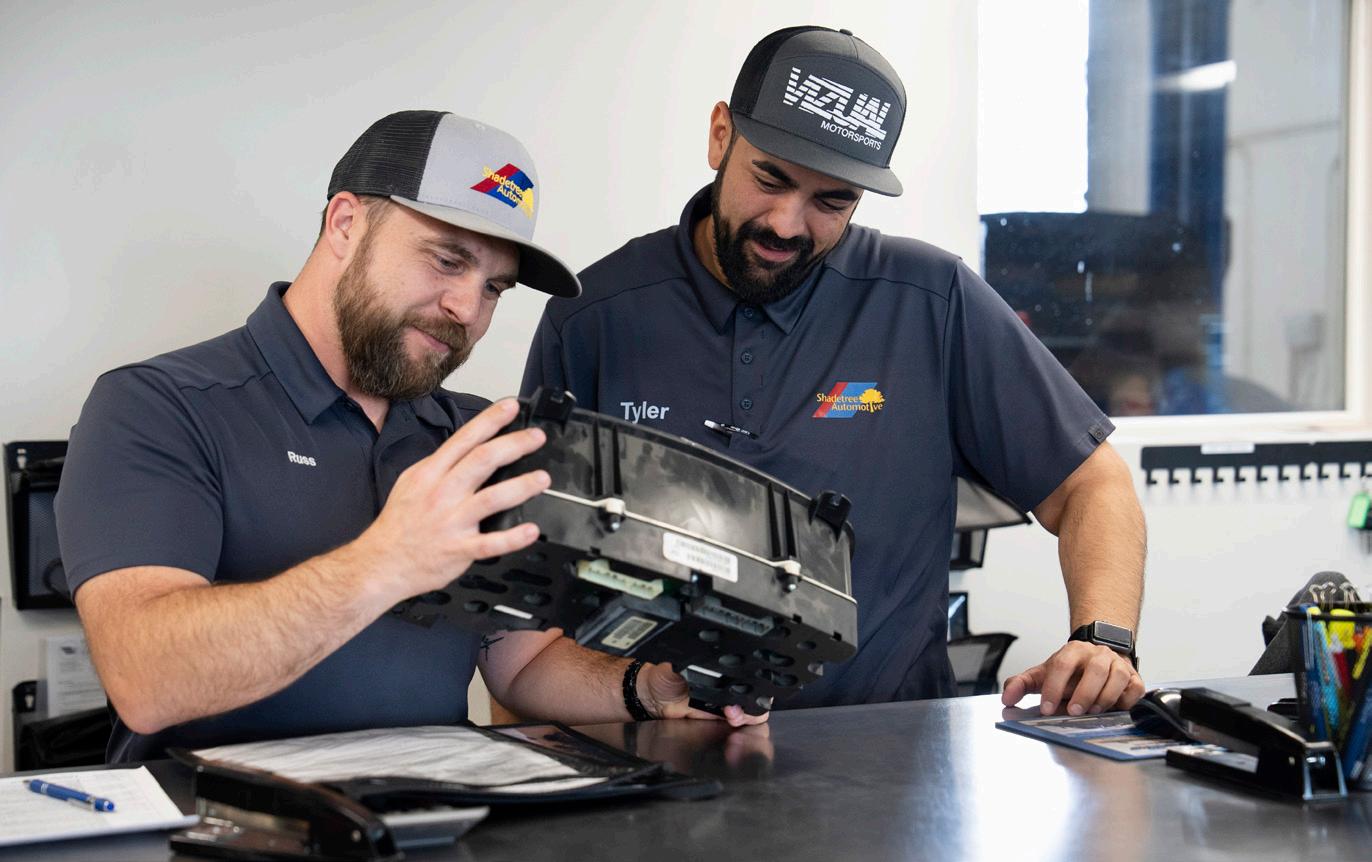
this time, Lambert hired new staff and worked in the vacant positions until they were filled. Lambert was able to work full-time in this location because he had good processes and strong leaders in place in his Shadetree Automotive location.
Within a year of Lambert taking over, the shop was profitable. He believes a big part of that was doing a lot of the legwork himself. His processes have helped turn the shop around to do $300,000 per month versus $30,000 and have raised the ARO from $111 to $1,300. Although Lambert changed the way the business was run, he retained 85% of the shop’s clients, and the ones that he lost are the clients that he didn’t want.
Lambert currently has three locations: his original Shadetree; A.B. Hadley; and a second Shadetree Automotive, a shop he purchased that didn’t have a stellar reputation, so he changed its name. He has done it in different ways, and he plans to grow to at least 10 locations, and knowing what he knows now, he would never do it how he did back in 2020. Why? It takes a long time to get everything up and running just to your standards, and then even longer after that to get sales up and proper staffing.
For future acquisitions, he plans on buying a business that is well-led with processes in place so all he has to do is make a few tweaks. That being said, he’s now in a position to purchase one of these shops now whereas the other shops he bought because of the price point when he didn’t have as great of a cash-flow as he does now.
“Our strategy moving forward will be buying the best-run shop in town,” Lambert says.
For a single or two-shop owner who’s considering taking on another location, Lambert has some words of wisdom.
“If you don’t have your main location optimized, you don’t have a chance. It doubles the chaos. If you don’t have the bandwidth to do it properly with one, you can’t do it with two.”




































































































OCTOBER 8-10, 2025












































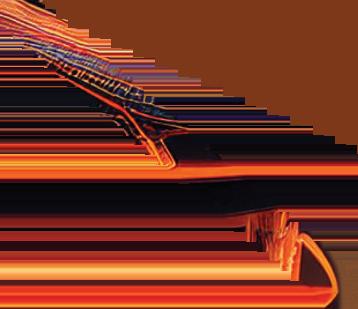



BY R. “DUTCH” SILVERSTEIN
I think that as shop owners, we can all agree that time is our most precious asset. We routinely use time as a barometer to measure efficiency and productivity. We order parts online, communicate with customers via text messages, develop strategies to help technicians save time by locating parts near their bays, and we’re constantly looking for ways to streamline operations to use time more effectively to our advantage—except, it seems, in qualifying customers over the phone who may be price shoppers.
Countless minutes are wasted, often culminating in hours of time squandered by shop owners as they try in vain to convince those whose focus is solely on price of the need to bring their car to our shop. It’s easy to understand why, as marketing to make the phone ring can be expensive, and shop owners want to capitalize on the money spent. I refer to the technique commonly used as the “twenty questions” tactic.
The S.W. asks multiple questions typically beginning with: “what makes you think you need...” and continues from there. It stems from the perplexing idea that even with the collective sum of human knowledge available a few keystrokes away on the internet, people are suddenly and inexplicably rendered ignorant, incapable of conveying their thoughts in any other way except to ask about price because “they don’t know what else to ask.” How absurd. The importance of investing our most valuable asset—time—wisely, with those who are a good fit for our business, can not be understated. If there are faster, more efficient ways to weed out those who aren’t good fits, we owe it to our employees, actual customers, and families to employ those methods and determine those whose values align with our own. In my experience as a 26-plus-year shop owner, what follows has proven itself to be a great way to qualify legitimate prospects and focus on customers who value my shop’s expertise and services. This is not a script; you need not quote it verbatim. What’s important to note is that if the prospect replies
with anything other than “yes,” then you can decide if it will be worthwhile to spend additional time with them.
To quote Nobel Prize laureate Milton Friedman: “The world runs on individuals pursuing their separate interests.” The goal, therefore, is to establish a mutually beneficial relationship based on shared interests. Simply put: your interests MUST directly align with theirs. If you find yourself fighting to establish that common ground, you’ll likely be wasting your time.
The example “dialogue” below highlights a technique that I used to successfully distinguish price shoppers from my ideal customers:
• You: “Thank you for calling {your shop name}, This is {your name}. How can I help you?”
• Prospect: “I have a Ford F-150 and I need a price for a water pump.”
• You: “Sure, I’m happy to help. Just a question or two first. After we speak, will you be calling other shops to compare price?”
• Prospect: “Yes.”
• You: “Is price what’s most important to you?”
• Prospect: “Yes.”
• You: “Thank you for the opportunity to be of service, but based on what you say is most important to you, we will not be a good fit; but I do have the name and number of a shop that may be a better fit for you.”
This approach is direct, efficient, and sets clear expectations. By asking upfront about the prospect’s priorities and intentions, we can quickly determine whether they’re a good fit for our shop. This method also shows appreciation for the prospect’s time and demonstrates candor, which can help maintain a positive tone even if they are not our type of customer. Remember, not everyone is.
The following additional questions are variations to help qualify telephone prospects who are price shoppers.
1. What is most important to you?
2. Have you called other shops before
you called us asking about their pricing?
3. If your car is at another shop, why are you calling us? Is it because of their price?
4. Which is more important to you, price or value?
Lastly, every decision in business has an associated opportunity cost. You could spend valuable time and energy attempting to justify your price, explaining features, benefits, and negotiating with the prospect. Only to lose the job anyway. Or you could have spent that time by setting an appointment with a prospect whose values align with yours.

R. “Dutch” Silverstein, who earned his Accredited Automotive Manager Certificate from AMI, owns and operates A&M Auto Service, a seven bay, eight lift shop in Pineville, North Carolina. Dutch was a captain for a major airline earning type ratings in a variety of aircraft including the Boeing 767/757, 737, 200, 300 and 400 series, Airbus 319/320/321, McDonnell Douglas MD80/DC9 and Fokker FK-28 mk 4000 and 1000. After medically retiring, he transitioned his parttime auto repair business into a full-time occupation.
dutch@dutchsgarage.com

